#lore analysis
Explore tagged Tumblr posts
Text
"The Visit" - Little Nightmares Short Comic
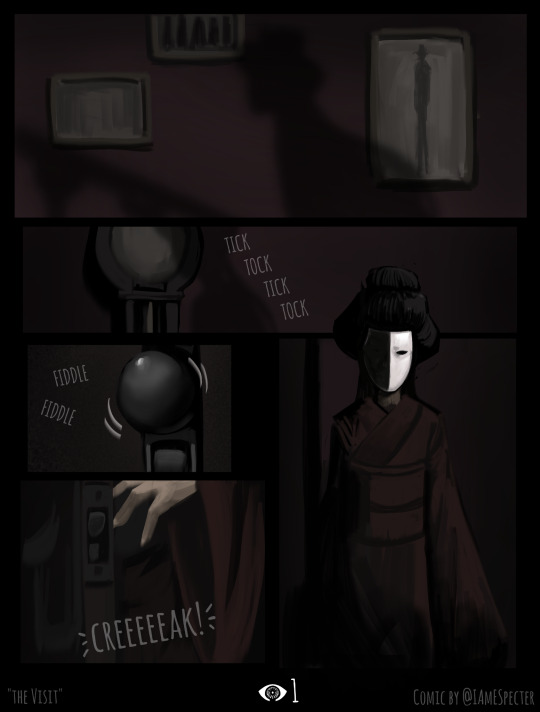
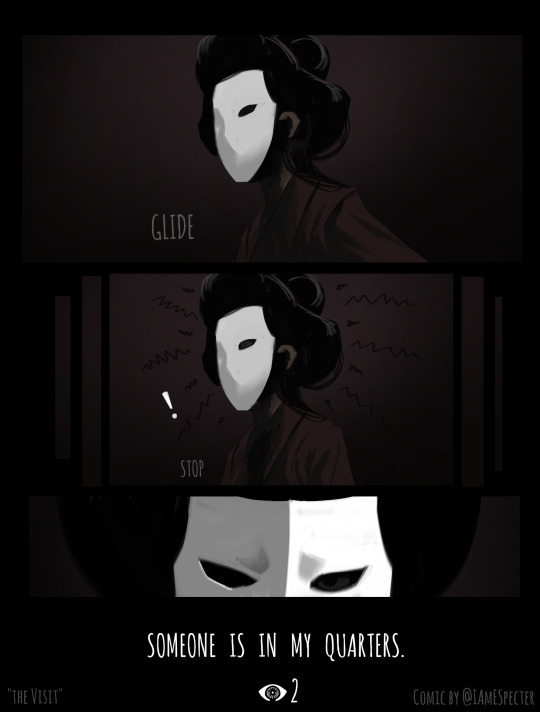

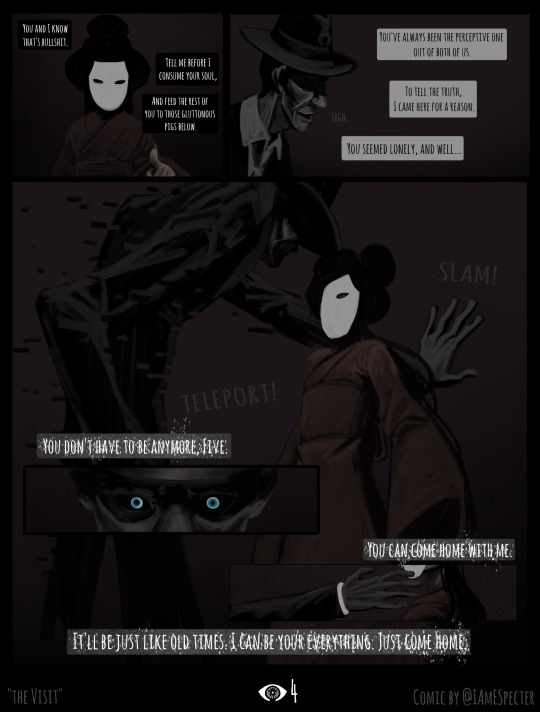
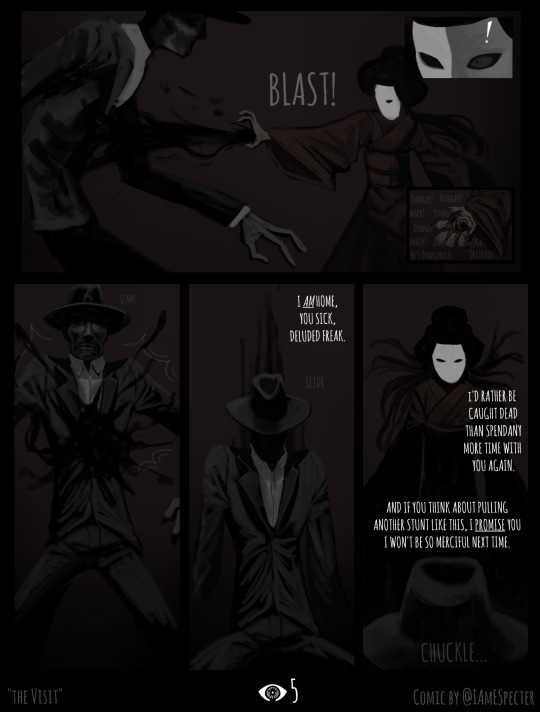
Anyways, I love batshit insane, bastard Thin Man. It's my favorite interpretation of him, and is actually what I believe him to be as in Little Nightmares 2. Let me explain.
At first, I liked the interpretation of the Thin Man wanting to save himself from repeating the same mistakes, only to be trapped in a time loop. This paradox is cool, but that's too hopeful for a game like Little Nightmares.
The world of LN is twisted, and cruel. Innocents turned guilty. Victims becoming abusers. Regular people becoming monsters. Children becoming Adults. And I think... The Thin Man is no exception to this rule. I think, he is most definitely a bastardized version of Mono.
A twisted view into what kind of monster Mono becomes, if he doesn't let go of his grievances; which, spoiler alert--he doesn't.
That older, more selfish version of the little paperbag boy who becomes so obsessed after his betrayal, that he was willing to kill his younger self for even trying to take his "friend" away from him. Similar to The Lady who hungers like her Guests', I think he is under the influence of the transmission's broadcasts like his own Viewers as well, in order to distract himself from the betrayal that happened to him.
After all, how do you sit in a chair for so long? The answer is by being distracted and preoccupied, of course. I think he doesn't allow himself to think about it entirely, because it'd make him spiral badly.
And when Mono finally opens the door to his room, that distraction is interrupted.
And while yes, I believe that he isn't even known to be real by the residents of the Pale City, I think he still influences them somewhat via the Transmission, and he is the blueprint on what makes every adult so monstrous and so one-track minded. His influence is just THAT strong.
Besides, he is the big bad of LN 2. You should feel sorry for the circumstances that lead him to why he chooses to remain in his seat, but not for the atrocities he commits because he's an adult that's purely powered by his instincts: which is to retrieve his long lost companion at all costs. Which, he doesn't even succeed at, seeing as to how he keeps snagging the wrong kid every damn cycle.
It's this neglectful nature that spurs on the generational abuse, and in turn, keeps the cycle going. Getting physical isn't the reason abuse exists, it's always been neglect; Physical only comes next either on it's own, or an after effect of neglect. Which is also why I've began to dislike the idea that The Thin Man has good intentions, the moment he is "set free" from his prison.
You can't expect a person to stay sane and clean after spending a lifetime in the belly of a huge beast that's constantly consuming him. And that, I think, is the case of The Thin Man; He is no longer the sweet little boy who just wants to keep his friend safe as much as possible, these intentions of his have been twisted to the utmost extent that he becomes obsessed. Possessive. Isolating.
Keeping his friend safe is no longer the priority, it's just keeping his friend by his side for as long as he can, whether she wants to or not.
As for the relevance of the topic to the comic? This comic is actually just a concept scenario of "What if, he knows who his friend really is, and knows where she lives". But I don't think The Thin Man canonically--nor fully-- is aware of the fact that The Lady might actually be the very person who he's looking for.
He is a paradox caused by his own actions, and his inability to break free from this toxic mindset. After all, the adults of LN are all monsters in their own way. And the most normal looking ones? They're typically the most depraved.
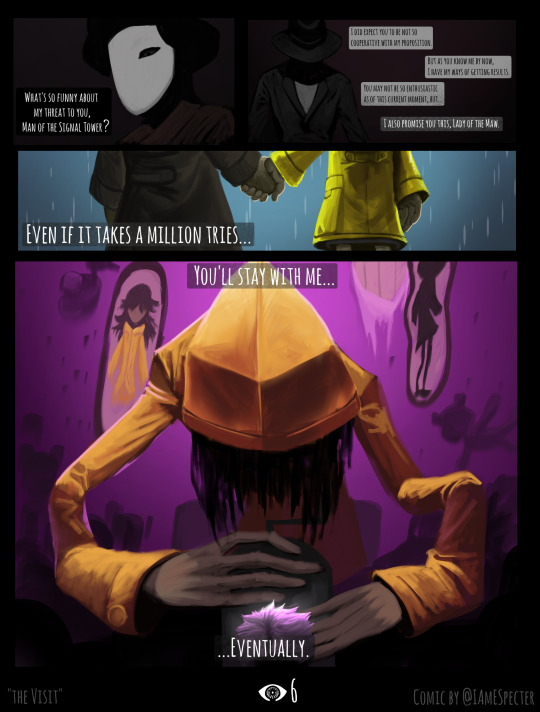
Well, that escalated quickly. Sorry for low quality ✌️
#little nightmares#little nightmares 2#tw dark themes#character analysis#lore analysis#The Thin Man#ln the thin man#the lady#ln the lady#mono#six#little nightmares the thin man#little nightmares the lady#little nightmares six#little nightmares mono#not really a thinlady ship post because it's more of a observation turned into “what if”#but hey you do you if you interpret this as a ship#comic#digital art#artists on tumblr#tw body horror
486 notes
·
View notes
Text
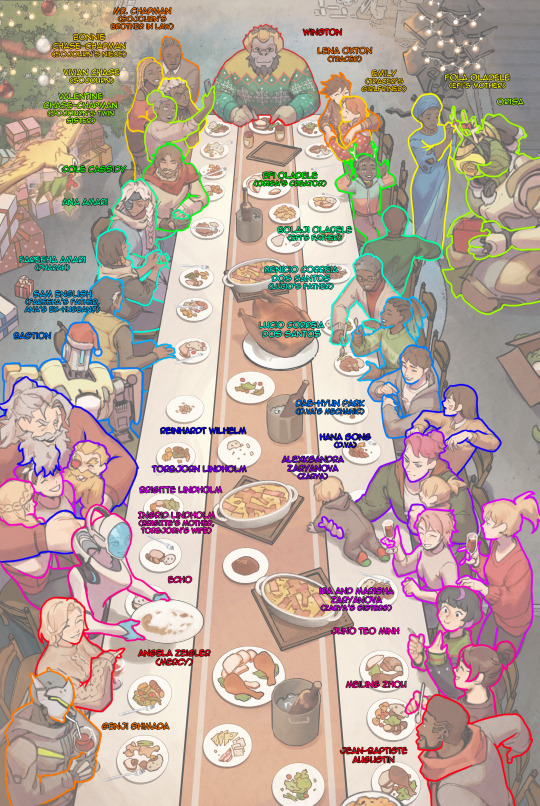
I made a guide to everyone at the dinner table. You're welcome.
#overwatch#overwatch lore#overwatch 2#lore analysis#that's far too many heroes I'm not going to tag them all
553 notes
·
View notes
Text
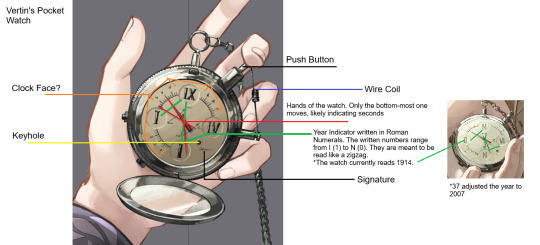
Vertin's Pocket Watch.
I'm actually surprised that not everyone figured out how to read the roman numerals on the watch, but at least you know now. 🫡
135 notes
·
View notes
Note
Hey out of curiosity you think about shadowsugar now that the new episode and we have an interaction for these two?
The canon dynamic rn came off to me as bitter exes/divorced couple who still are not over it.
Pre-Awakening update, I was speculating Shadow Milk Cookie to be in love with Eternal Sugar Cookie and vise versa and when he showed up as Lady in Azure, I had a theory that maybe
1. Devsis just dropped an easter egg
2. If he's involved in the story then maybe he has come to meet with ES to maybe inform that he has PV in the bag (cuz the episodes are happening at the same time and dude can conjure up portals so maybe he just came to boast) and then ES says "Me too!~" and they have a good laugh about scamming their other half off their soul jam once and for all
3. Dude would probably join HB as that disguise to get to Crispia so that he can stalk PV again.
I was sorta there with theory 2 but at the same, not really so leaving that behind...the bit he showed up was shocking to say the least lol
Let's take a quick look at their conversation at some of the integral parts of the conversation:

At the beginning, it may come off as a normal statement for ES. But pay attention to what she says "Don't tell me you seek happiness from me?"
This can imply he has done so in the past.
Also this dialogue:


It's the classic thing most exes, who you ended things badly, will say when they meet you again lol
"God you look awful."
ES is also doing the same here lmao
And SM takes it graciously cuz he's used to it lol
They both know she doesn't mean it.
But what adds the interesting twist in the dynamic is this piece of dialogue right here:

ES explicitly states she will not tolerate his "tricks". This could heavily suggest that SM has scammed/harmed her directly or indirectly in some way before which may have caused a rift between them.
To further illustrate the point,

"After all we've been through together?"
This dialogue is CRUCIAL in understanding their relationship.
Not to mention, since the episodes are all happening at the same time canonically, SM visited ONLY her even now. He didn't visit the other beasts. He's visiting her in a vulnerable moment.
Right after the moment he failed.
This actively CONFIRMS that they are very close. Or to be precise, were close. ES use to be very gracious and warm to him BUT-
Something changed.
And we get the reason right in the next dialogue:

SM lied to her or at the very least, manipulated her until she caught him. He used her and possibly took advantage of her.
SM recognising this quickly changes topics to the other awful stuff he did like to move attention away from that such as:




However, by the last dialogue, you can see ES growing impatient with that manipulation again cuz he's moving away from what she's saying and she doesn't really have the time to call him out so she just wants him to leave so that she can go back to HB.
However, SM is not done with her.

He doesn't wanna leave yet. He wants her to not think about what he did with her but instead focus on the other atrocities but then-
ES confirms what I said earlier:

They were close.
Very close.
To the point, they know eachother intimately even.
ES quite literally sees through his act and that's exactly why she dislikes him now. She doesn't like being manipulated by someone like him and being taken advantage of/used as a pawn.
This directly confirms that he has done so with her in the past. He has lied, decieved and manipulated her subtly to use her to his own benefit.
She knows this and knows now is not an exception either.
Which is why, she tells him to get out cuz she's got work to do.

And what he says next further solidifies this dynamic.







This interaction goes beyond just a conversation between exes.
SM and ES both know the fact that the other is very toxic and a bad influence.
ES is capable of manipulation and lying just like SM.
Both are red flags and they both know it.
But they are still bitter because they once had a good, happy relationship until one of them changed and that...shattered it and got them seperated.
That could explain why these two are arguably the MOST obsessed with their counterparts.
They really want to get that sense of connection, that understanding they once had with someone else...which is why they desperately want their "other half" to stay.
It is a way of coping, you can say even.
That is why, when SM got rejected in his endeavour, he went back to ES. His comfort spot or a "safe" zone.
Cuz they were close and even if he ruined it, like the toxic guy he is, he still reaches out to the one person he cared and cares for in his own twisted way.
And ES....doesnt want it. Not anymore.
She's found her happiness in HB who is a straightforward, simple person who has no double meaning in her words.
She doesnt want to go back to someone like him even though some of the qualities she admonishes him for are within her as well; manipulation and lying to be exact.
And that is the exact reason why SM is so bitter about it.
Now, not only had he lost the person he tried to move on with but that same equally toxic ex found a partner when he failed miserably and THAT PARTNER ACTUALLY DIDN'T RUN AWAY AND STAYED?! He's salty about it lol that's also why he basically said "Well you can be just a phase for her. Keep an eye on her LOL" while ES basically replies with "You're wrong. MY one is different than yours. THEY ARE MINE FOR LIFE."
That's also why SM is basically bitterly laughing at her before going off:



And as much as ES pretends she doesn't care about what he says, she still does as evidenced by here:



She does start paying more attention to her.
And if you saw the end of chapter then you can see her desperation for HB to not go.
Because she doesnt want to accept that none of this was real and that the sense of happiness she found from their relationship was nothing but for coping the loss of the past one.
She doesn't want to accept reality.
That is why she is hysterical when HB says she needs to leave.
So yeah! TLDR, ShadowSugar were DEFINITELY a thing in the past.
I think this is further evidenced by the fact that her garden still has remnants of it. It's still ridden with snakes which is SM's thing and goes against her aesthetic. Not to mention, despite being in a time crunch, she still makes out time to meet him when she realises it's him and SM goes to her of all beast cookies.
It definitely means something.
Also the fact, they have this conversation:

The first one especially.
It is a weird thing to discuss with ppl you don't trust or care about.
That particular set of dialogue is not something you talk with anyone about. It's unless they do trust the other person to not leak this trust thing that you discuss if you trust your own team mates.
It could further illustrate the fact that ES and SM eventually broke off due to trust issues because if two ppl in a relationship constantly gaslight, manipulate and lie to the other...Trust issues will rise at very least.
But that doesn't really stop them from reaching out to eachother still cuz they both know, they both are awful. They're petty and bitter over what the other did while also knowing they have done worse or maybe even better.
It's inverse Purelily basically (could be why their colours are reversed).
One is built on trust, truth, love, connection and respect; the other is built up on distrust, lies, hate, manipulation and disrespect.
#cookie run kingdom#Crk#Crk analysis#lore analysis#character analysis#shadow milk cookie#eternal sugar cookie#shadow milk crk#eternal sugar crk#ShadowSugar#shadow milk x eternal sugar#shadow milk cookie x eternal sugar cookie#Eternalshadow#Ngl I was rooting for them before this but now I think they're better off seperate#Both are toxic and unhealthy for eachother#They both know they are bad for eachother#But still reach out to other#Cuz that's what a toxic relationship is#Yk it's unhealthy but still keep seeking it for more and making the other and yourself miserable#Like here SM likes seeing ES miserable while ES likes making SM feel miserable about himself#It's mutually toxic and unhealthy
126 notes
·
View notes
Text
Cybertron's Atmosphere
A bit of a lore inconsistency of the aligned series is whether or not Cybertron has an atmosphere capable of sustaining humans.
Transformers Prime indicates that the planet lacks a breathable atmosphere, as Jack has to wear a suit when he visits Cybertron to get access to Vector Sigma-

-and the Decepticons even use the kids for ransom, threatening to expose them to Cybertron's atmosphere if the Autobots don't comply (which wouldn't be a threat if they were able to breathe)

However, we do see at least one evidence of an oxygen-rich atmosphere in Rescue Bots Academy, when Medix brings his bat friend to Cybertron on a field trip and it causes some chaos.

So does it, or does it not?
Well, based on timing, I would say that Dead Cybertron definitely does not have a breathable atmosphere, which is the version the Prime humans encounter. However, perhaps prior to its "Death" before Prime's beginning, and following its reawakening at the end, it was able to produce enough oxygen for organics to visit it.
Plus, there's plenty of references in other continuities about Cybertron having green, organic origins...

Oxygen is also needed for typical rust to form, which is mentioned quite a bit throughout the series on top of the "Cosmic Rust" virus.
So ultimately, I think Cybertron has oxygen when it is active and healthy, so maybe the Prime kids could come back to visit it some time minus the death-trap of before.
#transformers#rescue bots#rescuebots#transformers rescue bots#maccadam#transformers prime#cybertron#lore analysis#tfp#tfp jack darby#tfp miko#rafael esquivel#rescue bots academy#transformers beast wars
321 notes
·
View notes
Text
The History of Dracula’s Bloodline
Why is cinematic Dracula portrayed as a lonely aristocrat when his historical family ruled for centuries? Let's explore the facts, myths, and add a bit of personal perspective on the origins of vampires.
Historical Context
The prototype of Dracula — Vlad III Țepeș (1431–1476), ruler of Wallachia. His family, the House of Drăculești, was a branch of the Basarab dynasty, which ruled from the 14th century. The name “Dracula” comes from his father’s title, Vlad II Dracul (“The Dragon”), a member of the chivalric Order of the Dragon.
Key Figures:
Vlad II Dracul — father of Vlad Tepes, assassinated by nobles.
Vlad III Țepeș — infamous for impalements (hence "Tepes" — "The Impaler").
Radu III the Handsome — Vlad’s brother, who ruled with Ottoman support.
Michael the Brave (1593–1601) — the dynasty’s last significant ruler, who briefly united Wallachia, Transylvania, and Moldavia.
The Drăculești branch originated with Vlad II Dracul (son of Mircea the Elder) and gradually faded by the 18th century. The last legitimate descendant, Trașcă Drăculescu, marked the end of the dynasty.
Cinematic Dracula
This version of Dracula has no biological heirs, as vampires are typically depicted as infertile. His "family" consists of those he has turned—such as the three brides in Stoker’s novel. Over 500 years, he could have created thousands of "descendants," yet screenwriters prefer to portray him as solitary.
If vampires lived for 1,000 years and turned others every 200–300 years, there could be 8–10 generations over 2,000 years.
While Dracula traditionally has no biological heirs due to vampire infertility, there are notable exceptions in various adaptations. In the Castlevania series, Alucard is depicted as Dracula's son. Additionally, in the animated film series Hotel Transylvania, Dracula is portrayed as having a daughter named Mavis and a father named Vlad.
Headcanon: A Common Ancestor for Vampires?
"Do Dracula and other vampires share a common ancestor?" No canon answer, but here’s my take:
The First Vampire — a human who achieved eternal life through alchemy/magic but fell into a trap of their own making. Perhaps the gods cursed him, or he made a fatal mistake in his ritual. Others, seeing his power, replicated the process, but each curse mutated. This created various vampire clans with unique weaknesses (sunlight, garlic, silver).
Vlad Tepes may have inherited vampirism from a nameless progenitor, with his cruelty amplifying the darkness of his lineage. As the first clan, his descendants are inherently stronger than others. Meanwhile, other vampire clans emerged from those who sought immortality through blood rituals or dark pacts, each forming their own distinct bloodline with unique traits and weaknesses.
Conclusion
Dracula’s historical bloodline was real and played a significant role in Wallachian politics. In films, he is portrayed as a lone figure because it enhances the drama, making him darker and more mysterious. However, if we consider him as part of an ancient vampire lineage, his story becomes more than just a horror tale—it turns into a full-fledged legend with its own rules and traditions.
What’s your take: Should vampires share a common ancestor, or does every legend need its own origin? 💬
#vampire#vampires#hotel transylvania#artists on tumblr#dracula#count dracula#vlad dracula#vlad the impaler#vlad tepes#vampire lore#vampire headcanons#the bloodline#history#history facts#wallachia#castlevania#lore analysis#folklore
78 notes
·
View notes
Text
Messmer's Insignia
This is Messmer's insignia, stamped all over his Keep, as well as his soldiers' shields and tents. This post is going to be a canon-compliant lore analysis, meaning that not all of this will be explicitly mentioned in canon but will attempt to be compliant with what we do know explicitly.
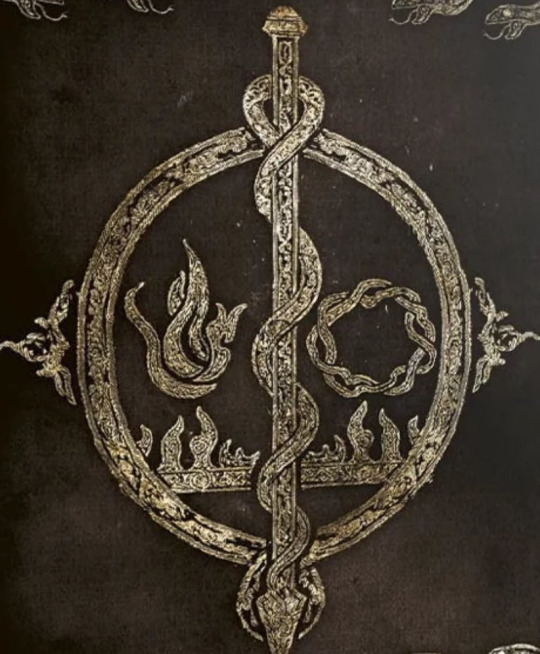
There are a few important elements coming together to make the insignia: 1. The left-hand flame 2. The right-hand woven ring 3. The outer ring 4. The overlaid, central spear
I'd like to pick these apart in the same way you might pick apart a heraldic coat of arms to look at what each piece might mean individually, as well as what the placement of some elements relative to others might symbolize.
The Left-Hand Flame
Along with the horizontal panel of flames, this is obviously symbolic of Messmer's flame. However, I do want to note that you can absolutely see a cute little winged serpent shape hidden in the flame's design with its head on the right, its tail on the left, and the central portion of the flame forming a wing. (Or maybe it's a dragon. Or maybe I need to seek help for my advanced brainrot, which is causing me to see things. You decide!) Given that Messmer's Phase 1 design—and his public persona—is a mixture of flame and specifically winged serpents, this seems an apt way to capture both ideas in one. A bit on the nose maybe, but hey, his day job is genocide, not graphic design (insert obligatory gRaPhIc dEsIgN iS mY pAsSiOn here).
The Right-Hand Ring
Many people have connected this to Marika's circlet, which I'm not sure I see. Her circlet is a lot more angularly braided, rather than the smooth coil shown here. Plus, I think that Marika's circlet is supposed to be similar to Miquella's Circlet of Light, in that it signifies a (fully) divine aspect of the wearer—something Messmer assuredly is not, since he is a demigod without grace (or, at least, with only the artificial grace bestowed by Marika's seal alone). But either way, none of what I'm about to say contradicts this interpretation, and you can have both be true at the same time.
Rather, I think a different interpretation might be that this is intertwined serpents, similar to the shape his own winged serpents make as they coil around his body. The winged serpent is typically a symbol of Caduceus in alchemical lore, of which Elden Ring is rife. The Caduceus is explicitly two intertwined snakes topped with wings. So that seems like the most straightforward interpretation for what this might be a nod to.
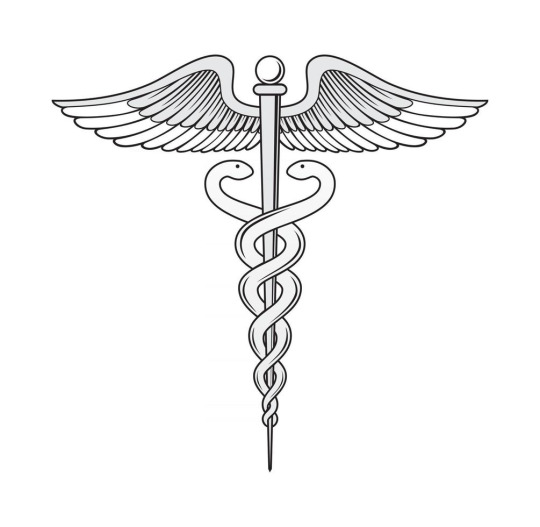
To learn more about Caduceus's role in alchemy, I highly recommend the two videos linked below by Max Derrat and Smoughtown. But the short of it is that the binding ritual that produces a rebis—a divine, single (merged) soul of masculine and feminine energies (e.g. Marika/Radagon)—requires some sort of binding material to happen properly. In alchemical lore, this binding material is the "prima materia", or the formless base of all matter in the universe associated with chaos and the void. The material is often referred to as Mercurius, named for the god Mercury who carries a Caduceus staff. Thus, we end up with binding/prima materia = Mercurius = Caduceus = 2 intertwined serpents.
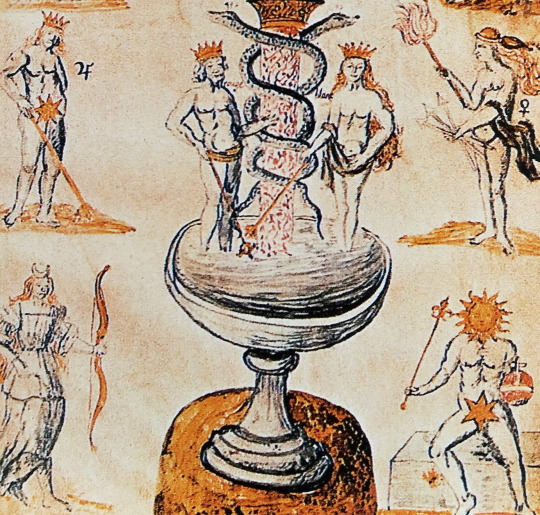
(Side note: This is also an EXCELLENT reason to believe that Messmer is the son of Marika and Radagon. The White Queen and Red King of alchemy are often shown with the Caduceus between them, which would seem to fit well with the idea of Marika and Radagon having a child between them that is associated with dual serpents.)
youtube
youtube
I also think there is a connection to the (singular) base serpent by way of the alchemical Caduceus, however. Besides the prima materia/uniting matter, Caduceus is also often used as a symbol of duality. Namely, it is a symbol of the tension between "higher" and "base" desires, with the former being associated with wisdom and the latter being associated with chaos. We absolutely see this in Messmer's lore, as we learn from the Winged Serpent Helm that his winged serpents act as wise friends that keep his base serpent in check. As such, the duality of the Caduceus may also represent the duality of the winged and base serpents. So this coiled symbol involving two snakes might also represent the singular base serpent indirectly, making it function like an image-based palimpsest. When we peel back the layers of one, we find evidence of the other.
The Outer Ring
I mostly think this is just meant to be a uniting graphical element. However, it is cute that it kind of evokes the imagery of a Great Rune, all of which are rings. Messmer does not have a Great Rune, as he did not participate in the shattering. So instead of an actual Great Rune, he ends up with this imitation insignia instead. Adorable. Maybe this is why his otherwise heraldic-looking insignia was designed as a circle instead of the more classical forms that heraldic coats-of-arms tend to take.
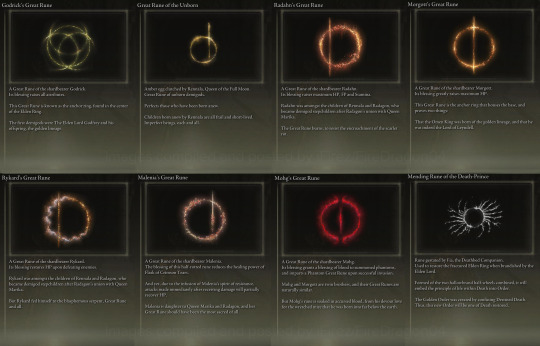
The Central Spear
In the center of the insignia, we get a spear wrapped with a singular(?) serpent. The question mark is there because we do not actually see the serpent tail, so you would be reasonable to question whether this is truly a singular serpent, or something like an unending ouroboros. (Or, you know, both.) I'm going to go forward with the assumption that this is a singular serpent. Cutely, the head of the spear forms the serpent's head.
Obviously, the most straightforward part is that the spear is Messmer's spear, the Spear of the Impaler. I find it highly apt that the spear *overlays* the other elements of the insignia, almost dominating them. War is definitely the thing Messmer is most publicly known for, as a myriad of NPCs—both spirit and corporeal—curse him for the honorless war that he has wrought without mentioning much else about him. Meanwhile, his internal relationship with his flame and serpentine nature is something really only known privately. After all, the Fire Knight set tells us that it was only those few knights under his personal command that knew the truth of how he felt regarding his flame and his serpentine nature.
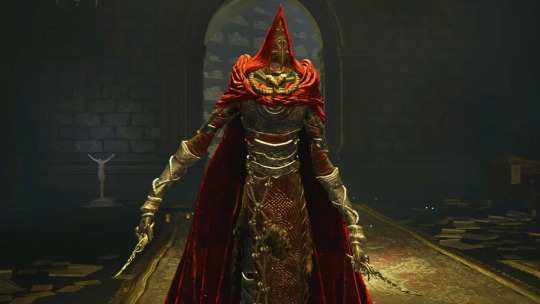
Armor of the Fire Knights under Messmer the Impaler's personal command. Distinguished by its red cape and twin golden snakes which adorn the neck, enhancing incantations of Messmer's flame. These were the only ones who truly knew Messmer. His flames, like serpents. The painful fate that accompanied his accursed form.
Building on this, the dominating nature of this graphical element is important in another way. The flame and other serpent imagery seems to be something intrinsic to Messmer: he was born with a serpentine nature, and was either born with or cursed with flame very early in his existence, too. Meanwhile, war is something that was *imposed upon him* as a request by his mother, as we learn from his armor set. He doesn't do genocide just because he enjoys fighting like Godfrey or Radahn; rather, he does it on behalf of Marika and ends up pretty sad, tired, and self-hating because of it. In this way, warfare ends up as an intrusive element in his life, similar to the way the spear almost seems to be a dominating, nearly intrusive element in the insignia's design.
The serpent coiled around the spear is also really interesting, because it appears to be a singular serpent in contrast to the dual coil on the right. The most straightforward interpretation is that this is a nod to his hidden inner nature as the (singular) base serpent.
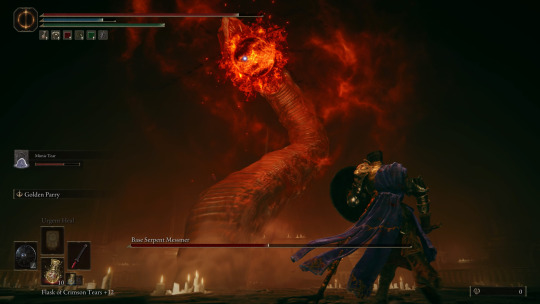
Given what we learned above about the Caduceus itself symbolizing a tension between higher and base desires—and repeated in Messmer's story as tension between the wise winged serpents and base serpent—I find it apt that the snake more associated with base desires is the one wrapped around the tool of war. I enjoy the link between warfare and base desires, as it ties into Elden Ring's overall themes around cycles of violence, explicitly characterizing the desire for violence and war as base.
The Central Spear: An Alternative Interpretation
This next bit is unhinged brainrot territory and what I think is a weaker interpretation of the spear symbolism than the above, so be warned. But I also think something interesting can be said if you look at this as a nod to the Rod of Asclepius. Asclepius is the god of healing and medicine, and the Rod of Asclepius (containing a single serpent wrapped around it) is often used as a symbol of medicine both in real life hospitals as well as in alchemical lore. Messmer's most obvious connection to medicine is Marika, as the Blessing of Marika and Remembrance of the Impaler items tell us that she attempted to heal him before finally gouging out his eye to seal the base serpent away instead.
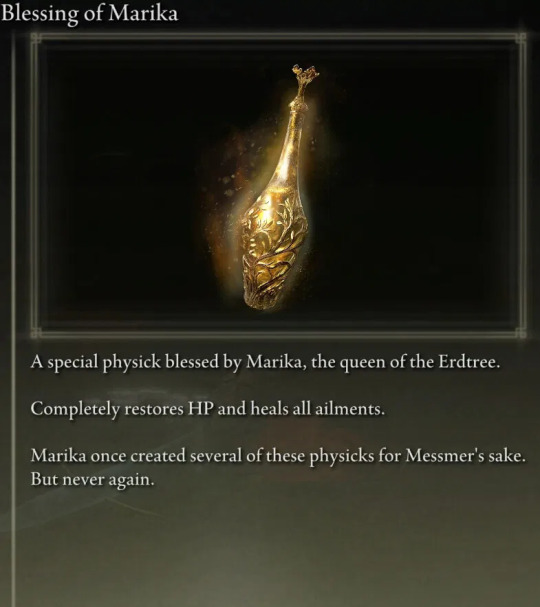
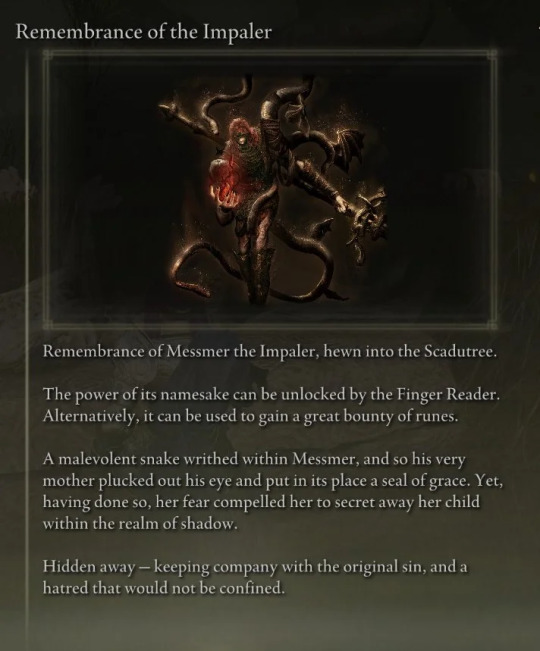
So if this is a nod to his mother's attempts to heal him, two things are true. First, this is an adorable nod to mom from Elden Ring's biggest momma's boy. Second, one might also read into it that these attempts to heal him of something he was naturally born with—and isn't intrinsically evil in and of itself, as far as I can tell—were actually intrusive.
Certainly from Marika's perspective, she worried that others would judge Messmer for his serpentine nature. In some sense, she was right, as Messmer's followers (like Black Knight Andreas) specifically rebelled against him after learning of it. But if your child is disabled or otherwise different in some way and people will judge them for it, is that actually a reason to seek a cure rather than an accommodation, especially if the cure comes with other costs? The answer is complex and varies by individual, of course. But in Messmer's case, we see signs of self-hatred and even neglect as a result of being taught that the base serpent is intrinsically evil. For evidence of this, see the linked post about how there are bits of shed skin on the base serpent, which is a symptom of neglect for snakes!
If Marika's cure resulted in self-hatred and neglect of a critical aspect of his being, can it really be said to be medicinal? Or is it just as intrusive an element in his life as warfare seems to be? I think if you believe the latter, this could be another reason to read this part of the design as intrusive and dominating over the other elements in the insignia that represent his natural self. That said, I think the base serpent interpretation is the more lore-accurate one, but it's fun to think about what it might mean as a symbol of Marika's attempted healing, anyway!
To Sum Up...
So overall while the design is maybe a slightly messy conglomeration of ideas and images, I think this insignia gives us so much. We get fire imagery, winged serpent imagery, base serpent symbolism, a graphic palimpsest of the winged and base serpents and the duality of man, warfare, warfare as a base desire, maybe a cute nod to Great Runes, and maybe even a cute nod to Momma and her attempts to heal. In this way, I think it functions in the same way as coats of arms do in heraldic design: they can also be pretty graphically messy, but it's on purpose to fit a lot of symbolism into a small space.
#elden ring#elden ring dlc#shadow of the erdtree#shadow of the erdtree spoilers#messmer the impaler#queen marika#alchemy#lore analysis#Youtube
181 notes
·
View notes
Text
GoBB COMMUNITY…I JUST REALISED SOMETHING HUGE…
We all know one of the biggest reveals in Chapter 7 was the fact that the Banban we all know and love is actually originally one of the mutants and was used to replace the original Banban (aka Flumbo).
What I don’t think many other people have realised is that this reveal was far from a last-minute plot twist. In fact, this plot point was actually being built up for far longer than anyone else has realised.
All the way back in Chapter 3, after the Tamataki and Chamataki boss fight, we find can find this image, showing the previously mentioned characters, Zolphius, the first appearance of Bittergiggle, and a bunch of music notes.
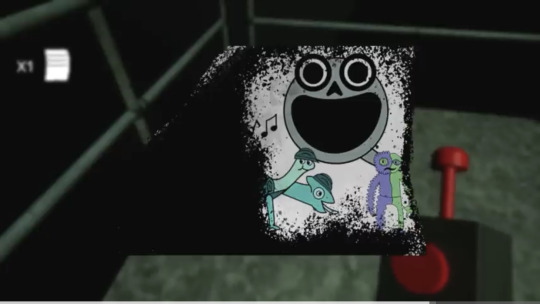
However, we see that the paper is partially destroyed, the edges being ripped and soiled. It’s very obvious that there are meant to be more unrevealed characters present here, just hidden for now. When I first saw this drawing, I thought Zolphius was the one the music notes were coming from, even though that made no sense. Zolphius was and still is never a character associated with music, so it had to be coming from someone else. We know for a fact now that these music notes are coming from Banban as per what we see in the Chapter 8 trailer. The music association even makes perfect sense since he’s playing a guitar in the mural.
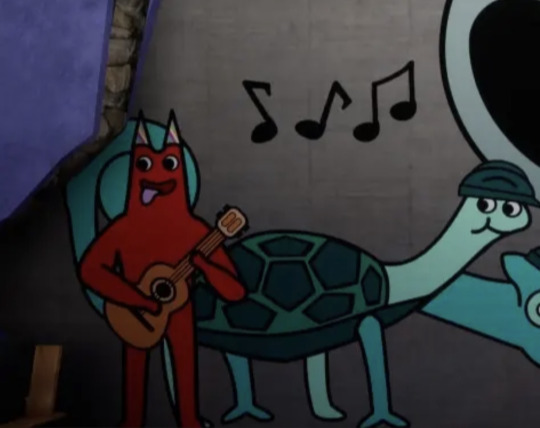
However, going back to Chapter 3, we find something else very interesting. In the first main segment of the game in the cafeteria, we see a bunch of children’s drawings on the floor. Now what just so happens to be one of these drawings?
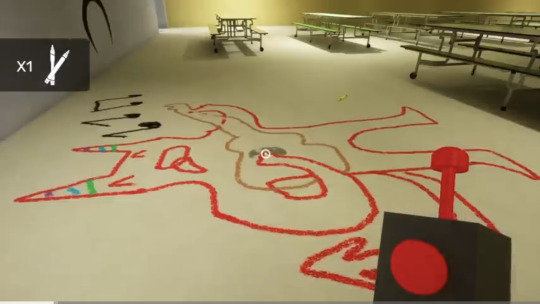
Banban playing a guitar with the exact same music notes.
This means that the reveal of Banban being a mutant was a plot point planned at least as far back as Chapter 3. Heck, because of the destroyed drawing, it’s possible even characters like Sir Dadadoo and Syringeon were planned as far back as here as well. Even more insane, the developers may have possibly had a fully thought-out story for the games at this point as well. This whole reveal was being hinted at for so long, just hiding in plain sight.
Faris and Ghepo you absolute motherfucking madlads…
#gobb#garten of banban#garten of banban 7#banban#tamataki and chamataki#zolphius#bittergiggle#syringeon#sir dadadoo#flumbo#euphoric brothers#lore analysis#i haven’t seen anyone else point this out so I had to
196 notes
·
View notes
Text
"I'm Not Him:" On Vidyadhara High Elders and Identical Twins
The question of whether Dan Heng and Dan Feng should be regarded as the same individual has been repeated ad nauseam, and, as is customary in fandom, the answer will change depend on who you ask -- that is, on one's interpretation of the text.
Personally, my experiences being raised as an identical twin strongly influence my reading of Dan Heng's character, specifically regarding his relationship to Dan Feng; I've observed numerous similarities between the treatment of this relationship and in societal norms and expectations I faced growing up as a twin.
Twins -- especially identical twins -- are often stereotyped as "copies" of one another, or even as two incomplete halves of a whole; any difference between them is considered an anomaly at best and a personal failing at worst. So well-established are these stereotypes that their enforcement disregards and undermines each twin's identity as a separate individual.
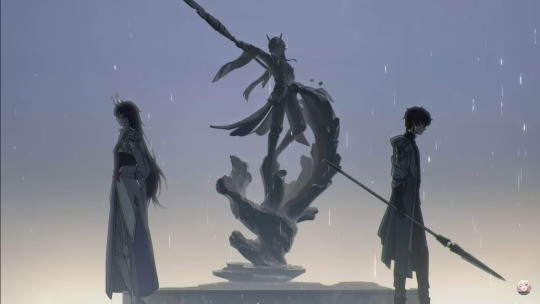
Moreover, the relationship between twins is decided by birthright rather than the individual's volition. Despite ongoing efforts to elevate the importance of chosen relationships relative to those decided by inheritance, society at large still tends to emphasize the latter. This can become problematic when the nature of a relationship takes precedence over how healthy or desirable it is for the involved individuals -- as is often the case with the "mirror image" twin stereotype.
Much like my attitude towards societal standards regarding twins, Dan Heng expresses great disdain towards the nature of his relationship with Dan Feng; the connection is assigned to him for reasons beyond his control, and he therefore resents it. Furthermore, in connection with this resentment, Dan Heng demonstrates deep and long-lasting internal struggles with his personal identity.
Therefore, I believe that a reading of the text that establishes Dan Heng and Dan Feng as two closely related, but completely separate, individuals is the least reductive to Dan Heng's character, and grants him the most sympathy and agency, legitimizing his persistent claim that, of Dan Feng, "I'm not him."
The Twin Experience
As an identical twin raised in a relatively close-minded environment, my upbringing closely aligned with societal standards regarding twin relationships.
When it comes to societal norms, twins are presumed identical effectively by definition, with any factors distinguishing a twin from their sibling considered exceptional. However, this presumption is incredibly damaging to the formation of a twin's personal identity. In reality, twins are indeed two separate individuals, much like any other two people, who are related to each other by no choice of their own; the "mirror image" stereotype applies solely by coincidence of them being born at the same time. Therefore, the expectation that a twin consistently match their sibling is really quite arbitrary and contrived. This expectation assigns artificial value to a twin's ability and/or willingness to conform to their sibling's actions and mannerisms. Subsequently, enforcement of the "mirror image" stereotype directly leads to struggles with self-esteem, self-identification, and self-awareness, as a twin internalizes the expectation that they must always match their sibling.
Growing up, I was rarely, if ever, given the opportunity to make my own choices -- solely by virtue of being a twin. I attended all of the same classes and extracurricular activities as my twin, ate all of the same things, was made to wear the same clothing, was given the same toys and gifts, and was expected to follow the same rules and do the same things at the same time -- regardless of my preferences (which, incidentally, I hardly even learned to recognize, just due to them never even being considered). If my twin earned an achievement or won an award in a contest, I was expected to win an equivalent award, and not doing so was treated as a personal failure, and would result in persistent questioning about why I hadn't met this expectation, as if I had done so deliberately -- which I only found out, much later in life, was completely arbitrary.
My parents' justification was that conforming to these expectations simply made raising me "easier." Society at large reflected this idea, too -- almost without exception. Indeed, humans favor efficiency; the phenomenon of "desire paths" is reliable evidence for this concept. The "mirror image" stereotype provides preconceived notions by which to judge twins, saving people the mental effort of regarding each twin as a separate person. Paradoxically, twins as a phenomenon are a rare enough statistic that the contrived identity of "twin" is, conversely, considered an exceptional and definitive identity -- as proven by my classmates almost invariably not bothering to learn my name, instead simply calling me "Twin." After all, it was a singular enough descriptor that it was equally as effective as my own name at distinguishing me as an individual -- from others' perspectives, anyway.
As an adolescent, I often wished I'd been born an only child so that I didn't have to face these expectations, and, as an adult -- once I'd gone off to college, miraculously (considering the circumstances), separate from my twin -- I seriously considered lying to people, telling them that I was an only child, to avoid these expectations.
Furthermore, being raised not to question authority compounded my struggles discovering my own identity and recognizing my own wants and needs; I didn't even realize that the freedom to make my own choices was something I was missing. People treated me based on assumptions and stereotypes because it was "easier" for them; this ultimately made my life proportionally more difficult than it would have been otherwise. It wasn't until well into my adulthood that I recognized how severely it damaged my self-esteem to internalize the expectation that I always match my twin, and thereby began the arduous task of unlearning this expectation.
Dan Heng as Dan Feng's "Mirror Image"
Dan Heng's experience as Dan Feng's reincarnation demonstrates substantial parallels to my experience growing up as a twin under the "mirror image" stereotype. In the Ichor of Two Dragons animated short, Dan Feng's specter even addresses Dan Heng as his "mirror image."
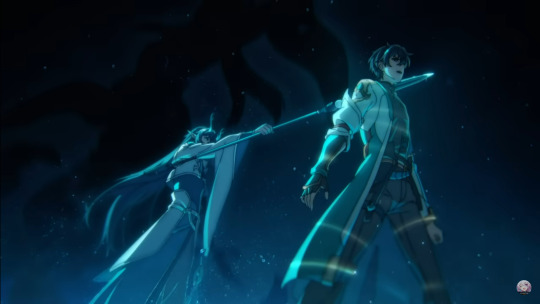
Much like a twin's relationship to their sibling, Dan Heng is born (or hatched, rather) as Dan Feng's reincarnation by coincidence rather than by his own personal choice. And, as a twin internalizes the expectation to match their sibling, the expectation that Dan Heng is identical to Dan Feng crucially shapes his identity.
On the Xianzhou Luofu, the High Elder reincarnation process bears great cultural significance. Dan Heng, while on the Luofu, thereby shoulders the default assumption that he mirror his predecessor, Dan Feng -- who was, incidentally, highly controversial as a political leader, giving these assumptions even deeper and more incriminating ramifications. The singularity of Dan Heng's identity as Dan Feng's reincarnation bears striking resemblance to the singularity of being a twin.
The combined cultural significance of these two factors -- Dan Feng as an individual, and hatching rebirth as a process -- provides Xianzhou Luofu residents with an exceptional, yet reductive, set of assumptions with which to regard Dan Heng. In the primary storyline, Dan Feng's exile carries over to Dan Heng's lifetime, severely hindering his ability to travel freely on the Luofu alongside his crewmates despite having personally committed no crimes, or even so much as set foot on the ship since the end of his imprisonment. Even after this exile is lifted, in the Wardance arc, Luofu officials consistently refer to Dan Heng not by name, or even by his role as a representative of the Astral Express -- which is arguably the most relevant, given the nature of Jing Yuan's invitation -- but as "the Imbibitor Lunae's reincarnation." These tendencies reflect the contrived expectation that Dan Heng's relationship to Dan Feng take precedence over any other aspect of his identity -- much like a twin's resemblance to their sibling.
As a Nameless...
Contrary to societal expectations, resemblance or bloodline do not make twins the same individual, and the same applies to Dan Heng and Dan Feng.
"Mirror image" stereotypes of twins tempted me to purport myself as an only child, so that others would have ample opportunity to recognize my individuality, rather than disregard it in favor of superficial assumptions. Dan Heng, likewise, resents his connection to Dan Feng, and keeps it secret for as long as he possibly can. While this seems due in no small part to Dan Feng's history as a convicted criminal, he appears begrudging of his connection to Dan Feng regardless, insisting that he has "no interest in commenting on the deeds and sins of Imbibitor Lunae," and would sever the relationship were he given the opportunity.
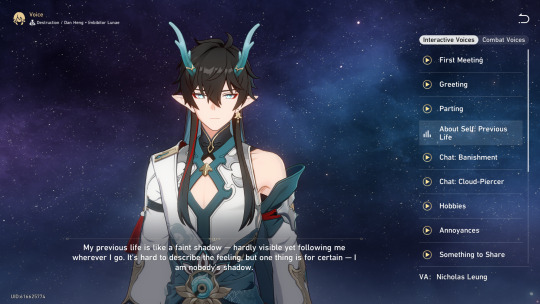
Indeed, the Xianzhou Luofu arc, and Dan Heng's role as Dan Feng's reincarnation, are certainly crucial to Dan Heng's character, but those alone do not encompass his entire character. As a member of the Astral Express crew, in the absence of Dan Feng's influence, Dan Heng experiences his own life and establishes his identity as an individual, rather than as a "copy" of someone else.
Granted, he initially struggles with this endeavor due to his low self-esteem and difficulty with self-identification. On top of his reluctance to acknowledge his personal history, he tends to diminish, or even disregard, his well-being and personal preferences. He regularly insists that his crewmates not pay too much mind to his safety or comfort, or not prioritize his opinions too far over their own; when asked for his input regarding what should be served for dinner on the Express, he gives the passive response "anything is fine." His diffidence is incongruous with his impressive combat prowess and his eagerness to support and protect his crewmates.
While I couldn't readily find canon evidence indicating causality between Dan Heng's lack of confidence and his relationship to Dan Feng, these two factors existing in tandem do closely mirror my own experience as a twin, in which I am certain they are directly connected.
Similar, but Separate
"Mirror image" stereotypes are based in twins often sharing many superficial similarities. However, the stereotype is reductive in that it erases twins' individuality in favor of simplifying their identities; in order to glean a complete and accurate understanding of each twin as a person, one must observe and contemplate beyond the stereotype. Such introspection is customary when regarding any other person, but on a societal level, when it comes to twins, this is often considered expending additional effort. And, of course, twins have no say in their inheritance nor in pervasive societal norms regarding their treatment.
Similarly, societal norms among the Vidyadhara are based in observable trends; the High Elder reincarnation process is distinct from typical hatching rebirth in that the descendant maintains certain similarities to their predecessor, purportedly including their appearance and personality, and is taught expected to fulfill the same political role. In the mission "The Dragon Returns Home," discussion of Dan Feng selecting Bailu as his successor, as well as Bailu's reluctance to fulfill the role, indicate that this decision is made entirely by the existing High Elder, with no consideration for the successor's individual volition. (Incidentally, Bailu, like Dan Heng, also suffers from a lack of confidence in her own abilities, questioning whether she's truly worthy of inheriting the title of High Elder.)
In both cases, reducing the individual in question to their relationship to another limits, or entirely eliminates, their opportunities to establish their own individual identities, with measurable consequence to their self-esteem and and self-identification.
Conversely, as an adult, I notice marked improvements in my self-esteem and sense of identity the more deliberately I separate myself from the twin and the expectation that we always match.
Dan Heng's role as a Nameless not only distinguishes and separates him from Dan Feng, but also demonstrates how freedom from the "mirror image" stereotype allows him to forge his own identity and bolster his self-confidence. In addition to all of his experiences trailblazing alongside his crewmates, this is most readily demonstrated in the iconic scene following the incident in the Shackling Prison: when confronting Taoran, Dan Heng asserts that, as a Nameless who leads a life distinct from that of Dan Feng, he has severed his connection to the Xianzhou Alliance, and is therefore exempt from the decree against harming other Vidyadhara on sacred ground. (And then, to prove his point, proceeds to impale Taoran on his spear.)

Considering all of the above evidence, I personally believe that calling Dan Heng and Dan Feng "one and the same" as individuals is both reductive and inaccurate. Granted, some of the exact circumstances surrounding Dan Feng's hatching rebirth remain up for debate, and he and Dan Heng do share a number of striking similarities, as is typical with the High Elder's hatching rebirth. However, careful consideration of Dan Heng's character demonstrates that, as a member of the Astral Express crew, he leads a life separate and distinct from that of Dan Feng. Indeed, Dan Heng argues as such by his own assertion; to assign him deeper connection to Dan Feng beyond his superficial "mirror image" runs counter to some of his core traits and values as a character -- much in the same way that regarding twins solely by stereotypes and societal norms of their siblinghood robs them of their individuality and complexity. As someone whose self-esteem and self-identity were severely adversely impacted by perpetuation of these stereotypes, and is only just beginning to overcome these obstacles as an adult, I hope that momentarily disregarding Dan Heng's connection to Dan Feng and allowing him to exist as a separate individual will afford a more complete and sympathetic reading of his character within the narrative of Honkai: Star Rail.
#dan heng#honkai star rail#hsr#hsr dan heng#star rail#dan feng#lore analysis#this was a great excuse to brush up on my vidyadhara lore#(me realizing it's been OVER A YEAR since i did the xianzhou luofu quests so. i was definitely rusty)#also this got kinda long but if you read the whole thing then THANKS!!#hsr spoilers
68 notes
·
View notes
Text
A Post Outlining Why the Clone Troopers are 100% Slaves
I'm pretty sure nobody is really arguing otherwise, but I was thinking about this earlier and decided to actually look up the definition of slavery, and holy shit the clones fit it even more than I thought like oh my lord-
I've also seen people not really acknowledge that the clones are literally slaves, so this is to set it in stone. This post is mostly pointless, but I wanted to make it anyway because it's actually crazy how much they fit the definition and I need people to know about that.
My main source I will be using is Britannica and their page on slavery, but I may also take a few others and use those as examples.
"slavery, condition in which one human being was owned by another. A slave was considered by law as property, or chattel, and was deprived of most of the rights ordinarily held by free persons."
The clones are canonically property of the Republic and clearly have no rights, otherwise half the shit that happens to them would not be happening due to being illegal (or it would at least be slightly more regulated). One aspect of this I think is important is that slavery is supposedly illegal in the Republic, and yet clones are owned by the very government that outlawed the owning of sentient beings. As I will discuss more, many of the rights sentients have in the Republic do not apply to the clones, showing that they have far less rights than those which are, as Britannica said, "ordinarily held by free persons."
It's also heavily implied that the clones are considered property/chattel by the fact that they are not legally considered sentients. Otherwise, again, them being owned by the Republic would not be legal or permitted. Sentient beings cannot be owned under Republic law, and since the clones are owned by the government (and again, seem to lack various rights which are applied to all sentients), this implies that they do not count as sentient beings. Honestly, it seems like culturally they are somewhat considered non-sentients due to basically being perceived as organic droids or something similar, thus they are more likely equated to property. Not even chattel, since that would imply that they are at least living beings, and clones are barely even tried as ones.
"The slave was a species of property; thus, he belonged to someone else."
I state this constantly throughout the entire analysis.
"In some societies slaves were considered movable property, in others immovable property, like real estate."
I don't know what TF that means so I don't know if it fits or not but one of the two probably fits.
"They were objects of the law, not its subjects. Thus, like an ox or an ax, the slave was not ordinarily held responsible for what he did."
This one is a bit complicated and debatable. They don't have rights, but are still somewhat held accountable for their actions. Then again, the use of the term/concept of "decommissioning" somewhat state otherwise. To the Kaminoans at the very least, the clones are products. So if they break the law or break certain rules or "fail" in some shape or form, they are thrown away. Not really punished for their actions, but treated more like a broken phone that doesn't work properly.
On top of this, I'm not sure if they would actually be tried in front of a court of law. They can be court martialed, but that's a bit different and very internal to the GAR, which is what owns them (yes, they are owned by the Republic in general, but most things regarding how they are regulated seem to be in relation to the GAR). If they were to commit a regular crime, they would most likely be decommissioned rather than tried in the same way as a regular civilian or natborn sentient. Again, while they can be punished, the law doesn't seem to apply to them in the same way. It would be up to the GAR rather than the justice system.
Honestly, this might come up later, but it's unlikely the clones would even be able to get legal representation, since they already don't even need to be court martialed to be straight up executed. And since they aren't legally considered sentients, it would be hard to properly try them in a court of law that isn't a military court. Like the quote says, you cannot try an ox or axe, thus, it would be hard to try a clone if they aren't considered to have any real free will. And even if they are, they aren't considered sentient and instead are property.
I guess a more accurate comparison would be if droids could be arrested and sued/tried vs getting simply destroyed (or the owner of said droid getting in trouble and destroying them/shutting them down). Highly unlike. And I believe that applies to the clones as well. Perhaps they could be declared too dangerous and be decommissioned, but not given a proper trial or anything.
If anyone disagrees with me on that, please do so in the reblogs or replies because I do want to hear your thoughts on if clones could be tried in a regular court (rather than a GAR court) and how that would even logistically work.
"He was not personally liable for torts or contracts."
These guys might be able to do some things like arrest warrants and mission reports, but they would NOT be able to sign a contract. I don't even have solid proof. I just know, and you do too. How would that even work? I don't think they can really even sign stuff outside of the GAR or their job.
"The slave usually had few rights and always fewer than his owner, but there were not many societies in which he had absolutely none."
I already explained how they have literally no rights. Honestly, the only reason this statement doesn't completely apply is due to the fact that they have absolutely no rights, as I will talk about more in the next statement.
"As there are limits in most societies on the extent to which animals may be abused, so there were limits in most societies on how much a slave could be abused."
The very fact that decommissioning/reconditioning is a thing, the Kaminoans aren't in trouble for all that child abuse, and how easy it would be to retaliate against clones reporting abuse (honestly unsure if a natborn would even be punished for abusing a clone) shows that pretty much all bets are off in regards to abuse. Plus, the fact that they have no rights and are barely considered living beings kind of makes it hard to find any proper protections for them.
"The slave was removed from lines of natal descent. Legally, and often socially, he had no kin. No relatives could stand up for his rights or get vengeance for him."
I'd say that the only legal kin the clones could possibly have are each other and maybe Jango, and there is no way the clones would be able to stand up for each others' rights. They honestly probably aren't legally considered kin anyway, so it would barely matter.
The clones can not vote, run for office, and have basically no form of government representation. They can not participate in politics in any real form.
"As an “outsider,” “marginal individual,” or “socially dead person” in the society where he was enslaved, his rights to participate in political decision making and other social activities were fewer than those enjoyed by his owner."
"The product of a slave’s labor could be claimed by someone else-"
Pretty much all clone labor is military related, and all the spoils of war are handed to the Republic. Not sure if this applies to regular soldiers anyway, but the point still stands.
"-who also frequently had the right to control his physical reproduction."
Do you really think the GAR would let the clones have kids?
Even if they did, I'm pretty sure they'd have the legal right to still prevent the clones from reproducing.
"Slavery was a form of dependent labor performed by a nonfamily member."
The clones are not related to anyone in the government. They may have some clone superior officers, but those clones don't own any clones, and the highest ranking officers are always natborns. The GAR also very much depends on the labor of the clones. Like, almost the entire GAR is just clones except for the people in charge of the GAR.
"The slave was deprived of personal liberty-"
The clones have no personal liberty because they are government property.
"-and the right to move about geographically as he desired."
The GAR very much controls where the clones can and cannot go. Sometimes they are allowed to go wherever they please, but the GAR still holds permanent control over where the clones are allowed to go.
"There were likely to be limits on his capacity to make choices with regard to his occupation and sexual partners as well."
The big point is that they have no choice but to be soldiers and work for the GAR. And as I said earlier, they definitely don't have any reproductive rights. This likely applies to romance as well.
"Slavery was usually, but not always, involuntary."
These bitches did not choose this. They were literally born into it. Honestly, they weren't even born into it; they were signed up for this before they even existed.
"If not all of these characterizations in their most restrictive forms applied to a slave, the slave regime in that place is likely to be characterized as “mild”; if almost all of them did, then it ordinarily would be characterized as “severe.”
Here are the parts that do not apply to the clones (or can be argued about):
.
.
.
.
.
There are none.
I actually put 2 quotes here before realizing that they actually do kind of apply.
While I didn't quote the entire article, that's because those parts weren't talking about the definition and what actually makes something slavery. When it comes to the actually qualifications, the clones' situation checks off every single one. I initially thought it would be more in the medium zone, but this is severe severe. The best I can give is that at least they get paid, but we don't actually know that. They are able to pay for things, but that might be due to odd jobs and discounts on stuff. Even then, the article doesn't mention pay of any kind, so it doesn't even matter.
There is also so many layers to their enslavement that makes it so much more twisted and disturbing. The harmful genetic modifications/experimentation (the aging thing specifically), the fact that they were created specifically to be slaves, the entire practice of decommissioning, them not even being considered sentient beings or people, and so much more.
I know why the show never acknowledges that they are 100% enslaved (acknowledging that all the clones we know and love are technically enslaved by the side we're rooting for and nobody is doing anything about it is a bit too dark), but it also drives me crazy how it feels like even the darkest versions of canon acknowledge that they are literally slaves in every possible sense of the word! The only time they are acknowledged to be slaves is by the antagonist of one episode, and his whole point is basically brushed aside!
We literally had a whole ass slavery arc! And Rex was right there with nothing to do! That would have been a perfect time to at least vaguely acknowledge that the clones are slaves! Like, Rex could vaguely mention that he somewhat relates to the slaves, since he doesn't exactly have much freedom, and the government barely considers him and his brothers to be people. Even if he is treated well and doesn't face the same abuse, they do have certain things in common. Then leave it at that. Literally anything.
Honestly, what drives me crazy about Rex being there is the fact that they really get into the horrors of slavery while completely ignoring that Rex is already in that exact situation, he's just not being tortured! Like, he feels bad for all the slaves not just because they are being abused but because they are enslaved as though he isn't already a slave himself! That is literally you, dude! You are in the exact same boat as them, you just aren't being whipped.
The only differences here are:
The clones aren't tortured or receive cruel and unusual punishments (the latter is debatable)
The Jedi don't abuse them (anyone else could, though, and the Jedi don't because they are nice to them)
They are treated slightly better in general
I can't actually really think of anything else. There are so many things that are basically the same, just dressed up differently. Even the dying from work and getting killed for just existing are the same! Fuck, the slave chips are just decommissioning!
Rex clearly feels bad for Anakin's sad backstory and all the slaves on Zygerria, but it's like he doesn't even realize that he has so much in common with them! It's just not obvious at first because the clones are treated kindly and aren't outright abused (most of them, at least).
Anyway, the point is: the clones are slaves. Like, the slaveist of slaves. And I need canon to acknowledge that at some point somewhere by some kind of character that canon acknowledges to be right. Because we all know it already. Canon already depicts the horrors of slavery. I just need them to say it out loud for once.
#star wars#star wars the clone wars#star wars tcw#sw tcw#sw the clone wars#sw clone wars#clone troopers#the clone wars#clone wars#clone trooper lore#fictional politics#star wars politics#tw slavery#discussion#lore analysis#lore discussion#star wars analysis#captain rex#clone wars rex#clone trooper rex#tcw rex
46 notes
·
View notes
Text
GAHHHHHH CAN I JUST SAY IT REALLY PISSES ME OFF WHEN PEOPLE SAY THIS END SCREEN OF LN1 MEANS THAT ANOTHER SHIP IS COMING???? TERICHO NEEDS TO STOP PROMOTING THIS THEORY ISTG
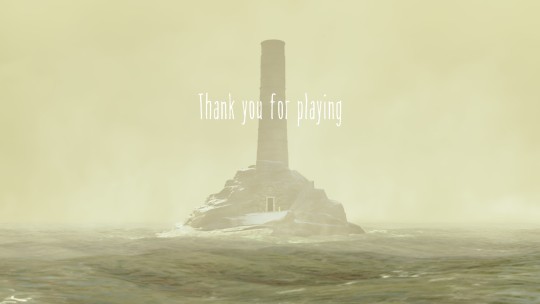
NO, THE FOGHORN THAT SOUNDS WHEN YOU PRESS ENTER DOES NOT MEAN THERE'S ANOTHER SHIP!!!! BECAUSE THE MAW IS FULLY SUBMERGED IN THIS!!!! THE FOGHORN IMPLIED THAT THE SHIP THAT WAS DELIVERING GUESTS ON BOARD JUST LEFT!!!! STOP SAYING THIS IS ANOTHER SHIP!!!!! RAAAAAAAAAAAAA!!!!
I HAVE BEEN SAYING THIS FOR LITERAL YEARS AND EVERYTIME, IT FEELS LIKE I'M SCREAMING AT A BRICK WALL!!!
If you *critically* think about it, it ABSOLUTELY MAKES NO SENSE THAT IT WOULD BE ANOTHER SHIP THAT'S ARRIVING.
Because:
The Maw is fully submerged at this point.
We are very much shown that The Maw ONLY accepts Guests WHEN the top part/the "mouth" has emerged. As shown in this sequence of the game, and in the concept art.
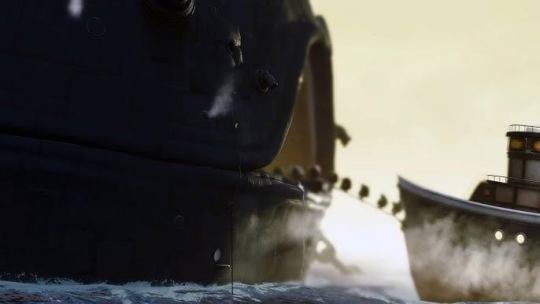

It's stated that The Maw "arrives" ONCE a year. NEVER in the same place, but ALWAYS at the same time. SO NO, IT'S *NOT* ACCEPTING GUESTS OVER BECAUSE IT'S CLEARLY FULLY SETTLED BACK DOWN AGAIN. WHY WOULD IT WASTE RESOURCES TO SUBMERGE ITSELF IF IT WAS GOING TO RE-EMERGE AGAIN MOMENTS LATER.
The door Six exits out of is likely a maintenance door; for cleaning the Chimney in case of blockage. Especially because of the fact that there is a visible staircase that leads up to the smokestack. PLUS, IF IT WERE FOR THE GUESTS TO COME THROUGH; WHY IS IT A SLIM ENTRANCE UNLIKE THE ACTUAL ENTRANCE OF THE MAW? BECAUSE IT'S ONLY MEANT FOR WORKERS LIKE ROGER/THE JANITOR.
It's heavily implied that while Six and The Lady aren't related, nor are they stuck in a time-loop-- coughcoughlikeMonoandtheThinManCOUGH-- it's still possible that Six is intended to be The Next Lady of the Maw. Mostly because of the whole boss fight that doesn't really resemble a fight, but moreso a ritualistic passing of the torch. And the implications of multiple Ladies existing throughout the millenia.
To be clear; I don't think Six will be stuck inside The Maw for long. As her description states, she belongs elsewhere.
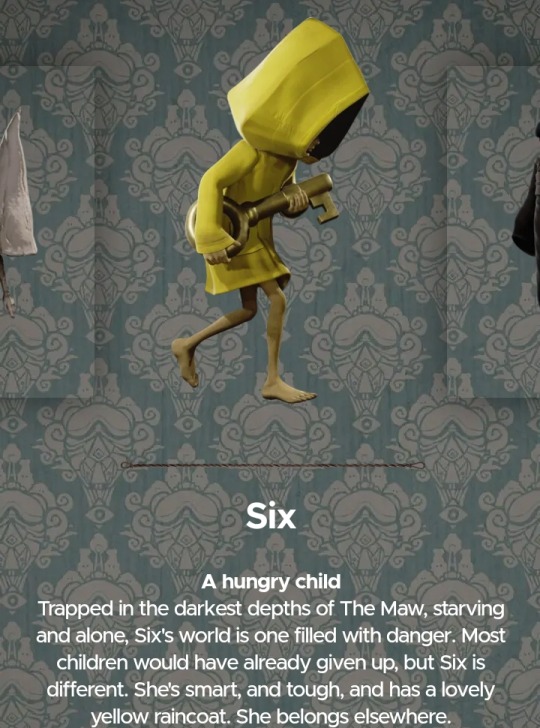
Which could mean that my girl *might* make a comeback for LN3, but I wouldn't hold it against Supermassive Games if LN3 doesn't even make a single cameo towards Six/making her appear. Because either way, I fully understand each outcome.
#ziku's insane rambles#little nightmares#little nightmares 2#LN#ln six#six ln#six little nightmares#little nightmares six#theory#character analysis#lore analysis#RAAAAAAA IT PISSES ME OFF SO MUCH!!!!#out of all the theories in the LN community this one angers me the most#Because all you really need is to think about it just a little bit more critically and then you'd find the most glaring issue about it#and why it doesn't make sense at all#It's also why I don't really like Tericho as a theorist;#the guy feels like he's both intellectual at one point then spills a buncha random nonsense#I'm so peeved off by this theory I hate it with my entire being!!!!!!!!!
264 notes
·
View notes
Text
youtube
hi. guess who got so irritated by the misconceptions around Eramis that it finally kicked me into making that lore analysis channel that i was thinking about for a few years or so
#destiny 2#eramis#video essay#eramiskel#destiny 2 lore#lore analysis#this is my first stint into actual video editing btw pls be patient#Youtube
64 notes
·
View notes
Text
Deep Analysis — 2.6 Poster
Hello everyone! As you can tell this is a post meant for the CN Spoiler audience. While the tags will be seen, same rules apply: If you're in any way sticking to global patches, I'd suggest not looking into this thread until way later. For any CN enjoyers, have fun!

*Placeholder for spoilers
I've also begun using both tumblr and twitter interchangeably so that I can manage the distribution of both GLB and CN Lore posts. The thread version of this post is here.
Deep Ch. 9 Poster Analysis: Folie et Déraison
Welcome! As of today (18/02/25), Bluepoch has released the poster for 2.6, and there are a lot of cryptic implications in this poster than I expected.

The formatting and amount of images here will be limited due to me being limited to my phone to write at the moment, but I will link specific parts of my twitter thread to be able to show the other images missed. Let's not dwell on my antics for longer and let's get started.
1. Title and Artwork
A. Title
"Folie et Déraison: Historie de la Folie" is a 1961 book written by Michel Foucault. The book describes how madness has evolved over the course of history from the middle ages to the 18th Century.


B. The Main Cast
Recoleta (Ficciones)
Aleph
Vertin
Sonetto
The Idealist
The Physician
Dores
C. The Poster's Main Elements
The entire poster represents 3 main figures: the panopticon/prison, a skull-like head showing the layers of the mind, and 3 inner humanoid shapes that show the depth of the panopticon.



D. Art Style
While I can't distinguish the exact form (ironic coming from an art student), this art style definitely uses Doodle/Scribble as a part of the drawing while also integrating the use of word art to reinforce the shape and message.
The way the lines are drawn are in a manner that makes it: hasty, jagged, sharp, and rough. It's meant to give that feeling of uneasiness, and express the desperation and mania founded in a decline in one's psychological health.
E. The Red Path
The red line represents paths and depth, with the addition of showing a hexagon-like shape in the middle and ladders across each layer. It also crosses over the key phrases, coincidentally symbolizing the shackles of the outermost figure.


F. Key Figures
The key phrase in this poster is "Our Mind Is a Prison," repeated all over the poster and being one of the leading mediums of the head shape. In the image below, it specially reads as "Our Mind Is a Prison," cycling into "A Prison of our Mind."

G. The Figures
As said earlier, there are three figures within the panopticon/head. The outermost figure encompasses the two others, the middle figure is shown to be in a sitting/dejected position, and the innermost figure is in a fetal position, protecting the hexagon shape.
H. The Description
"A place of exile for prisoners,
Countless fervent poems and ideals!
Countless illusions entwined into a labyrinth?
Countless versions of "you" drifting within...
Infinite possibilities lie hidden here,
And we have come for them."
-Merui's translation
2. Implied Symbolisms
A. Mental Spiral — With the ongoing themes of madness and illusions, and the key phrase, it's fitting that the poster shows a mental spiral and an interpretation of the "prison of your own mind" metaphor.
B. Labyrinth and Identity — Adding to the mental spiral symbolism, the panopticon is shown as a labyrinth. It can represent how difficult it is to navigate one's understanding of themselves and others. It adds to the complexity of interpersonal relationships and personal identity.
C. Death and Burial — My friend pointed out that the yellow scribbles that show the outermost layer of the prison can be interpreted as a grave. The head also shows a deliberately-placed hole that looks like an eye socket.
D. Pregnancy (and motherhood) — The outermost figure is shown to be encompassing the other two figures, while the innermost is in a fetal position. Here, it can imply pregnancy and likely the chapter's ties to Vertin and Urd (Dores), and their likely connection to each other. Additionally, someone pointed out that the figure in the fetal position looks like Vertin's body position in the profile screen!
3. The Main Cast
Recoleta and Aleph - Recoleta (Ficciones) and Aleph are both the main featured characters for this chapter, being described to be players of a "cruel game" (via Merui's translation of the broadcast description). Here in these posts, you'll find an analysis for both characters + the implications of the name "Recoleta."
It's likely that the two of them are either prisoners of the panopticon, or those who join Vertin and Sonetto in venturing deep in the labyrinth. They will definitely have some interesting stories to share.
Vertin and Sonetto - Speaking of which, Vertin and Sonetto are in the chapter together as a duo again; it's the first time since 1.2! This might be a chance for their individual characters and their relationship to be explored once again.
Many things between them are still left unsaid, and I would really want to see how this chapter will affect their relationship and understandings of each other. We might get a further glimpse of their origins too, who knows!
Dores - While we don't know who The Idealist and The Physician are, we definitely know who Dores is. What she went through to come back in this chapter, we don't know yet, but it can be assumed that she's imprisoned in this panopticon, and we will have a glimpse of her as a person.
4. Story Links and Initial Expectations
A.
Folie et Déraison is the 9th Chapter of the Main Series and a direct continuation from 2.4 (Last Evenings on Earth), taking place after Igor's betrayal and Dores' kidnapping in Ch. 8, and the artificial "Storm" experiment in 2.4.
Taking place in Ushuaia, Argentina, it can be assumed that the story will be set in the now-former Ushuaia Prison, which is a prison based on the design of a radial panopticon. This chapter will also be set in 1991 via the timeline, making it a few months after Ch. 8.
I'm assuming that the prison here is being used as a temporary Manus base, where Dores is being kept during the time that she had remained hostage by Igor and the Manus Vindictae by extension. The fact that Vertin and Sonetto are going by themselves is already scary enough, but I'm sure they'll be able to push through.
B.
The chapter will once more go into psychological themes, exploring the mind of oneself and "madness" as a concept. In that case, the main story—alongside Ficciones and Aleph's characters—will definitely deal with heavy and disturbing themes as well.
With the cast, we will definitely explore Dores/Urd as a character. With the line "countless versions of 'you' drifting within," we might see the story solidify her identity as Urd; which may bring a confirmation about her previous identities and her relationship with Vertin.
We'll also see two paths that will finally cross each other after too long. Besides that, there will definitely be a lot of reveals and new questions will be made, which is what I'm really hoping for.
5. Last Notes
This chapter definitely makes me excited. This poster is insanely done well and I really appreciate how cryptic it looks while it sets the message outright. The words are likely handwritten, so I applaud the art direction for that.
Aside from the anxiety over the PV and character design, I really have high hopes for this story and how it will push the plot forward. Thanks for reading and lets have fun theorizing for the rest of the week!
#reverse 1999#lore analysis#major 2.6 spoilers#vertin#sonetto#urd reverse 1999#ficciones#aleph reverse 1999
104 notes
·
View notes
Text
Series analysis: How David Marcus came back to life and came to be a part of Saavik's crew in Star Trek Eridani?
When the showrunners announced that David Marcus was going to be a part of this show, fans were perplexed, but his survival, or rather revival, was hinted at through many episode’s plots, and even clarified in a later comic.
This slight retcon of The Search for Spock's ending and (And even a bit of The Undiscovered Country) still fits very well into the Star Trek continuity, even if because of it, certain fans decide to see Eridani as its own alternate universe, independent from the TOS timeline.
But what really happened then, for David Marcus to be Capt. Saavik's science officer? This post aims to be a lore synthesis of that!
In the comic STAR TREK: Genesis "Life from lifelessness", the storyline pitched by show creators in pre-production is brought to the public’s eyes in a clear chronology for the first time.
In this retcon, after David is stabbed in the upper chest by the Klingon, Saavik still has the communicator held up to her face and intones "Admiral, David is dead", conserving the following scene of Kirk's devastation on the bridge.
Then the comic diverges, with Saavik eyeing David's still form, and facing the Klingons remaining on the surface. She asks that since David has died with the honours of combat, that she may be allowed to bestow upon him the honours of her people, meaning to share a meld with him as his body is near its end, as Sarek had told Kirk about at the beginning of the movie. They allow it, somewhat reluctantly, but Klingons can't exactly refuse this honour to a fallen warrior, no matter how poor of a warrior he was.
Saavik stands and walks over to David's still body, melding them. In the meld-space, David gasps awake, and he and Saavik share a conversation, in which she explains that he is dying. His mind takes notice of the physical pain he is in, and he then grows very afraid, as would any person facing their impending doom. He begs Saavik to not let him go, and she obliges, the mental manifestation of her body holding David into a hug as she tries to reassure him, telling him that she is there.
Saavik being a mildly experienced telepath and David's psyche being aptly terrified, they inadvertently form a psychic bond, which is the kai-telsu, or sibling bond mentioned in Star Trek Eridani S2 Ep. 10. This bond's creation, while also knocking Saavik out of the meld, interlinks hers and David's katra, their living spirit, and while David briefly flatlined and experienced cerebral death during the meld, this connection not only prevents his "spirit" or "soul" from passing, but also allow his mind to re-enter his body after the end of the meld, thus saving his life. His body, while still badly damaged, then begins to undergo the Genesis effect.
When interviewed by Marvel's Starburst magazine in their No. 91 issue, one of the show's creator said that "If bacteria can grow into bugs and creatures, and if Spock's baby, toddler and later child-aged body can be made to survive alone and without food, Genesis can start to heal David." When asked if it was a case of Deus Ex Machina, she replied "What does God need with a machine? We have Genesis right at our fingertips!"
David is then stabilized by the beginning of his healing, and Saavik attempts to start a healing trance for him. She stays by his and young Spock's body's side until Kirk and the crew arrive, to the Admiral's shock, when Saavik says that David gave his life to save them, but that she tried her best to restore it.
While Genesis's protomater instability increases, causing Spock's body to experience its last surge of aging, David's own body is affected as well, with a rapid regeneration of some of his nerves and muscular structures, growing and collapsing in quick succession.
- This event leaves him with long term consequences, some of his symptoms being similar to epilepsy, migraines as well as issues with mobility, mostly when standing up for extended periods. In many episodes of Eridani, we see accommodations for David, namely a more structured chair at the science station on the Bridge, as well as orthotics braces he wears on away missions as a preventive measure to pain and mobility issues.
David is beamed aboard the Klingon Bird-Of-Prey, as Saavik was holding his unconscious body. Away from Genesis' surge, Dr. McCoy is able to begin surgery on him and truly stabilize his body until they could get to Vulcan. McCoy also questions Saavik's method to keep his mind into his body beyond cerebral death until the regeneration could kickstart, at which she confesses at having botched the meld, accidentally bonding his katra to hers, which she at first perceives as a grave transgression. David never holds it against her.
On Vulcan, David remains unconscious for a long time while being treated by Vulcan doctors, Dr. McCoy and mind-healers, who later found out that his kai-telsu bond to Saavik could not be removed, lest David suffer grave psychological consequences. David's still fragile state is a great part of the reason why Saavik remained on Vulcan during the event of The Voyage Home, as she is scared that the distance could potentially send her friend into shock with such a young bond.
S1 Ep. 10 "Under thy skin" explores early on David's disability, as when he is bodyswaped with First Officer Kyral, he experienced an abled body for the first time in years and spoke of the whiplash of it.
David's resurrection is also touched upon in S1 Ep. 17 of Star Trek Eridani "Does the abyss stare back?", in which a mission to a planet of people worshipping death causes him to be captured as an heretic who cheated his own demise. It also causes him to reflect upon his action with Genesis again, and think about his human mortality once more.
In S1 Finale "By star benign" it is also stated that Saavik has had to argue with Starfleet Academy regarding David's admission in their field science program so that he could join the fleet, namely for his scientific fraud on Genesis, but mostly because most of the Admiralty believed his disability to be too great of a liability on a spaceship.
On another note, while David's resurrection wasn't planned at the time of making The Undiscovered Country, to be fair, Kirk was still truthful in his assessment, Klingons killed his son. And while he was brought back, he still underwent extensive trauma, as well as difficult medical experiences and disabilities that followed him for the rest of his life.
In a later interview, show creator Pauline Birchwood spoke about how David's disability, while opening an amazing opportunity for representation in the franchise, was also a way to avoid undermining Nimoy's direction with David's death in The Search For Spock, in which the young scientist's demise takes root in a very classic tragedy of reaping what you sow, and in David's case, it's his scientific hubris and impatience causing death and destruction, including his own. And now, through Eridani, a rebirth, life from lifelessness.
#st eridani#star trek eridani#star trek series#eridani#star trek#tv series#star trek tos#david marcus#analysis#character analysis#lore analysis#lore#pauline i. birchwood#meta#david marcus as a disabled character#disability representation#david kirk#david james marcus#saavik#s'chn t'gai saavik#star trek iii: the search for spock#star trek comics
36 notes
·
View notes
Text
"Let the tides carry you back to me." has always been among one of my favourite lines in Telomeres, and so, having listened to it again recently, a little idea popped into my head. Let me explain:
While ocean tides/currents is a very common metaphor, there's an underlying meaning to it. The ocean is a beautiful, but somewhat cruel place: tides can leave you stranded on a sandbank, or sweap you away before you even know it.
To put it in short, no object or creature that goes into the ocean comes out the same. For the tides to carry something back to you, something you've lost, it will be and always will be changed: eroded.
The cliffside will fall, the cave will crumble, etc etc.
With this in mind, we're yet again greeted with another example of Vessel asking for something he can't truly have. The person he wants will not be the same as they were before; they "collapse" into him, breaking apart, but still, to him, it's "the start of something."
His memory is warped, they are warped, and it'll stay that way.
However, what I would like to add is that, in DYWTYLM, it's theorised that instead of Vessel speaking to a second person, he's instead talking to himself.
Of course, this makes the song itself much more emotional (to me). Finding love for yourself is one of the hardest things you can do, but it has to be done to find love in others.
With that idea (stay with me here), the lyrics "Do you roll with the waves? Or do you duck into deep blue safety?" match up (generally) with Telomeres, which is mostly interpretated as being towards someone else.
So, what if some lines in Telemores are directed to himself as well?
Keep in mind, the tides don't just erode and carry objects (sediment), they also reflect. The Atlantic is one big mirror, and Vessel is staring into it's "deep blue safety" wondering what, or, rather, who, he was before he was Vessel.
Overall, the album name, "This Place Will Become Your Tomb", either being directed at Vessel or Vessel to Sleep (and being a Halo quote lmao), is more metaphorical than literal.
Who he was before Vessel sits in that coffin, not his physical body.
#more specifically about the verses I'd say: 1 = V to S. Chorus 1 = V to S. 2 = S to V. Bridge = V to V. Chorus 2 = S to V#but that changes from time to time lol#if we want to look at it from another perspective it could also be about grief?#the tides return as does grief in many many different forms in many many places and faces but it always finds its way back to you#but that could just be me making a mountain out of a mole hill#I still think it could be interesting though!#if anybody else has some ideas feel completely free to add!#especially you Aqua and Drift (if you see this) I'm always SAT for your analysis#mel's rambles#<- living up to that tag today#sleep token#st#vessel#vessel sleep token#tpwbyt#this place will become your tomb#telomeres#song telomeres#dywtylm#song dywtylm#tmbte#take me back to eden#lyric analysis#lore analysis#sleep token lore
83 notes
·
View notes
Text
What element is your Vision? (and how do you guess)
(ao3 version, with bonus in the end notes!)
!!!SPOILER WARNINGS FOR ALL QUESTS (event, character story, Archon, and Interlude Archon) PRIOR TO 5.6!!!
A Vision (or a god’s eye or gaze, in the original CN text) has no proper origin within the game’s lore.
The people of Teyvat are unsure whether Vision bearers are natural elemental beings (see: Volume 1 of Breeze Amidst the Forests) or those deemed worthy by the Seven. But, upon a quick analysis, one may be able to pinpoint what element a character will be able to get within their given region.
There are jokes among fans in the community about the loss commonly experienced by Anemo Vision holders, some going so far as to claim that the loss is usually the death of a sibling figure with an Electro Vision (this is… circumstantial). But there is some truth to this!
Before I get into it, this is what’s gonna happen:
I’ll point out several factors that might go into what element a character’s Vision is going to be based on my observations,
These parameters are entirely characterization-based, meaning that little to no information about a character will usually result in a toss-up or an unclear assignment.
These parameters ignore aesthetics/color palettes, positions of power, or their reputation from outsiders’ perspective.
This is all based on my understanding of the story elements as a whole and are subject to inconsistencies due to lack of information or being debunked by Hoyoverse moving forward (it is Version 5.6 at time of writing).
Spoiler warnings have been tagged, this is your last chance!
Section I: The Aspects of a Vision
From what I’ve gathered, there are three (3) main aspects that a character’s element will depend on: where they live/came from, how they deal with their hardships, and where on their journeys they are.
1. Regional ideals
This is the oft-ignored aspect of Vision assignments because, generally speaking, these seem to be a little vague and wishy-washy and rarely ever tackled explicitly within the narrative. I’ll explain their involvement in Section II in full detail.
Mondstadt: Freedom
Poetry/ballad
Freedom
Resistance
There is an emphasis here on Freedom, but the guiding principles’ idea of freedom differs from the Archon’s, which is a holistic freedom that involves the fight for freedom (resistance) and the desire to speak about these fights and ideas of freedom (poetry/ballad).
Liyue: Contracts/commerce
Prosperity
Diligence
Gold
Liyue’s understanding of commerce is not wholly business-oriented. The prosperity found in the exchange of diligently made goods and diligently enacted services is the ‘commerce’ Morax speaks of.
The understanding between an exchange, the connection made between one or more individuals, unspoken or explicitly discussed. Gold is not Mora, moreso the hearts of each Liyuen, their pride in their occupation and craft.
Inazuma: Eternity
Transience/the fleeting world
Elegance
Light
The irony of Inazuma’s national ideal is that it is at odds with the nation’s principles, showing the thematic conflict between the Archon and her people. Everything changes (transience), so one must make the continued decision between base wants and needs (elegance), to always pursue the higher purpose instead of stagnating or settling for less (light).
“A sealed eternity may, perhaps, look magnificent, but its essence is death,” so says the Philosophies of Light (like, the talent book), the so-called ‘yearning’ of the land of thunder.
Sumeru: Wisdom
Ingenuity
Admonition
Praxis
Sumeru’s wisdom lies in enacting knowledge (praxis), embodying and teaching it (admonition), and synthesizing it with your own lived experiences (ingenuity). A want and willingness to learn and grow is at the heart of every Sumeran’s goals, even if they don’t know it.
Fontaine: Justice
Fairness/equity
Justice
Order
Justice is blind, in Fontaine, but only in the way that morality plays a large part in enacting the law (equity). Serving this appeal to morals (justice) brings order to all.
This is the most wishy washy of all the national/regional ideals thus far (it gets worse from here on), as it fails to be properly emphasized within the Archon Quest. It’s properly represented by individual character stories, but fails to be synthesized as a whole, a common problem to the region’s writing and characterization.
Natlan: War
Rivalry/contention
Kindling
Conflict
Natlan’s alleged ideal is one of war but what it really means is a meek difference in opinion.
The name of the region’s base principles are misleading as well. Upon reading each, the principles mostly point at a ‘confidence in victory and learning in failure’ (rivalry/contention), the ‘espoused benefit of sacrifice’ (kindling), and ‘sincerity and being true to one’s motivations’ (conflict). A far cry from the more aggressive actual meaning of the words war, contention, kindling, and conflict.
Snezhnaya, Nod-Krai, and Khaenri’ah are still up for debate, as we have little-to-no verifiable or consistent information on each region’s ideals, whoever in the region has Elemental Authority, etc.
(Our only case for Snezhnaya is Tartaglia, as Arlecchino received her Vision as Peruere (see: Arlecchino Character Stories, Vision), and Wanderer received his Vision after erasing Scaramouche. That’s not really a big enough sample size for any theorizing.)
2. Elemental ideals
The one thing to note here, before everything, is that it’s easy to pinpoint the element of a character when considering who holds (or held) Elemental Authority.
So, consider the beliefs, motivations, and ideologies of every being that held onto a Gnosis that still had its Authority when it comes to that element.
(The only exception for Hydro is Furina, who accepted her Vision from Neuvillette fairly recently after Focalors gave him his Authority back. Every Archon thus far (barring Ei) has been holding onto their Gnoses since the Archon War.)
With that out of the way…
Anemo. Choosing freedom in spite of loss.
Yes, it is still ‘losing someone makes them Anemo,’ but the overgeneralization of a death of a close friend or relative harms interpretations. Wouldn’t that make Diluc Anemo instead of Pyro? Or Kaveh? Or, god forbid, Dori?
A loss so substantial that it changes and almost engulfs one’s entire life is the key. This is why we can still include Sayu whose master left her, Sucrose whose friends abandoned her, and Lynette whose equal standing with Lyney was severed when he became her protector when joining the Hearth.
It is their choice to commit to continue living freely (as much as they can) to tell the tale that makes them Anemo.
Examples being: Kazuha choosing to venture further instead of clinging stubbornly to revenge. Xiao choosing to be part of Liyue’s peaceful modern day in spite of the losses he’d accrued during its time of strife. Jean choosing to fight for Mondstadt despite her loss of self as she continues on Vennessa’s and the Gunnhildr legacy. And well, the guy himself, Venti choosing to live on and tell the tales his friend lived through and look up at the sky he always yearned to see despite his overwhelming grief.
Geo. Pride in one’s experience/niche/passion.
Every Geo character is proud of what they do and how they do it, almost boasting and arrogant in their pride. Ningguang in her position as Liyue’s wealthiest and the Qixing’s Tianquan. Arataki Itto with his oni heritage. Albedo as an alchemist and/or Khemia practitioner.
This pride is the driving force of their character, the core to all their choices. Other aspects remain secondary, almost trivial. It’s why Noelle who is proud of her position as maid is Geo but Bennett who is proud of his adventuring is not.
This is exemplified, really, by the way Zhongli is in constant awe of the minutiae of regular everyday Liyuens, of the legends, songs, crafts, strategies, weapons, etc. that his hardwork as a warmonger had produced. Yes, it makes him seem a little self-centered but hey… he helped make all that.
Dendro. Letting one’s past guide every future.
Dendro characters are shaped by their learned beliefs.
Often they gain their Visions when paying forward an act of kindness, letting it shape their motivations (Collei, Kirara) or finally eliminating any room for doubt or uncertainty that once plagued them earlier on in their lives (Baizhu, Tighnari, Kinich).
Often their motivations are in service of higher purposes, altruistic in spite of their perceived self-benefit (Alhaitham, for example, whose egoism leads him to believe his acts of pursuing correctness and truth are only in service of himself. He is [often] incorrect [or outright lying]).
It’s difficult to properly pinpoint their oh moments, because you have to dig through every single bit of their stories to properly pin down why what they did earned them their Vision.
Our best example is Rana, who received her Dendro Vision when finally remembering all she’d forgotten from Arana, whose teachings from childhood she still espoused and embodied in her adult life despite the memory wipe.
The other best example being, well, Nahida herself, whose literal accumulated knowledge becomes so powerful it can power cities and timeloop experiments and fortify rocks from earthquakes, etc. That’s on top of [gestures vaguely at Greater Lord Rukkhadevata] that. I think you get it.
Pyro. Forging one’s own legacy.
Pyro has to be the easiest because of the veritable deluge of Pyro characters in the game.
Often Pyro characters are passionately pursuing a goal to reckless abandon, motivated by parental figures or mentors who are either gone or otherwise preoccupied.
Amber wants to be an Outrider because her missing grandfather was an Outrider.
Bennett wants to be an adventurer because all his dads are adventurers.
Diluc wanted to be a knight because his father had always wanted to be a knight.
Gaming chose his own path because Yip Tak had chosen his own path as well.
I could go on and on, but you can see how easy to verify it is. I think you get the picture.
The keypoint, as always, is reckless abandon. It doesn’t matter when they receive their Vision, but often Pyro characters will be in dogged pursuit of their passions that they’d end up in significant danger one way or another.
These aspects are also present in Mavuika. As disappointed as I am with the trajectory of her arc, I can’t deny that her reckless desire to save Natlan by turning herself into a battery like Xbalanque did all those centuries ago is what shapes Pyro as an element.
Hydro. Salvation in sacrifice.
Because Focalors had held Authority for so long, it is very easy to understand why sacrifice ended up defining Hydro characters.
Many Hydro characters have a facade to uphold, one they choose out of necessity. And often, they use these facades to enact their own means of justice, sacrificing their true selves to save everyone else.
Ayato’s story quest is the best example of this outside of Fontaine’s fifth act. Ironically considered the worst character story quest, it showcases a young man who has to play into a facade stuck on so well, it’s impossible to see where the Inazuman politician starts and Ayaka’s brother ends.
Electro. Choosing duty over love/the self.
Similar to Hydro, because Yae Miko held onto the Electro Gnosis for so long, it’s hard not to see why Electro characters have to choose their duties over their love or passion or selves.
Often this choice of duty is an act of love, like Yae Miko choosing to maintain Ei’s wishes in spite of the solitude.
Lisa gave up her spot as the Akademiya’s best and brightest to be a librarian in Mondstadt. Cyno chose to be the General Mahamatra to keep his oath with Hermanubis rather than raising Collei at home. Kujou Sara chose to protect her home within an inch of her life.
Fischl is an interesting asterisk to this, choosing to be the Prinzessin out of love for the craft, but also out of love for poor lonely Amy. Without the Prinzessin, there is no Oz, and Amy would be all alone.
Probably the most interesting outlier.
Cryo. Solitude and yearning.
We don’t know enough about whoever is holding Cryo Authority or Snezhnaya. But one thing Cryo characters do have in common is a gaping yearning in themselves. For belongingness (Kaeya, Shenhe, Ayaka, and yes, Aloy), for the correct, best version of one’s self (Chongyun, Layla), for a lost future (Qiqi, Wriothesley).
I’ll keep an eye moving forward for this one, but I hope this makes sense.
3. Constellations and fates
This is really less of a factor and more of a consideration with regards to how the elemental assignments are justified within the game’s lore.
What does that mean?
Plainly put, every character’s constellation is a point in their development that coincides with when or how they were chosen by the element they have (given that they weren’t born an elemental, like some of the Archons and dragons).
This is what solidified my theory that characterization is one of the primary bases for how elements are chosen for each character. A character’s dreams (their Vision) have a clear trajectory based on a plot (their fate). Their goal is self-actualization.
That doesn’t necessarily mean that Vision bearers lose their Visions (their dreams) when they finally reach their goals. But it does explain why many Vision bearers are able to live as though nothing’s wrong when they’re apart from their little Vision baubles.
Examples being:
Kuki Shinobu
Arataki Itto
Diluc Ragnvindr
Jiangxue (from Wangshu Inn)
(Apparently, this should include a lot of unnamed characters that joined the Watatsumi Army during the Vision Hunt but… we don’t know any of them and honestly that’s such a thematic and ideological hot mess that I don’t even wanna touch it.)
A recent example of a Vision bearer conquering their fate, so to speak, would be Hu Tao, whose fate was actually achieved in the Lantern Rite event for 5.3.
There’s even a scene between her and Zhongli (clip below; timestamp: 20:28) in the quest that recited all of her constellations in sequential order. My friend Alina made a wonderful breakdown of this scene and the sentiments it lost in translation.
youtube
Hu Tao achieving her C6 in this cutscene (clip below) means that she’s achieved her fate.
youtube
Section II: The Case Study
Though predictable to many, I will be doing a case study of the one character who everyone knew was going to be playable but whose element no one really expected: Wanderer.
Prior to Inversion of Genesis, when Scaramouche was defeated at the end of the Archon Quest, there was no doubt in anyone’s minds that he was going to end up playable. And true to everyone’s expectations, he was.
But due to a) his aesthetics, b) origins, and c) general vibe, people were convinced he was going to be Electro.
So, let’s play devil’s advocate.
Name(s): Kabukimono/Kunikuzushi/Scaramouche/Wanderer Place of Origin: Inazuma Current home: Sumeru Species: Puppet
Information from
Yae Miko (the end of the Inazuma Archon Quest);
Raiden Ei (voicelines);
The Husk of Opulent Dreams artifact set;
Scattered notes around Tatarasuna;
Katsuragikiri Nagamasa
The description from Shakkei Pavilion; and,
Scaramouche’s own monologue about his own past (Sumeru Archon Quest)
(OPTIONAL) Unreconciled Stars event story quest;
(OPTIONAL) Kaedehara Kazuha’s story quest;
(OPTIONAL) Hues of the Violet Evergarden event story quest;
Scaramouche was a vindictive guy seemingly shaped by his lack of heart.
He was abandoned by his mother, rejected by the first few people he felt he belonged with, and was still actively hurting in his grief for his first family.
His first community, though initially accepting, had rejected him after his pleas for his mother’s assistance during Tatarasuna’s time of need were turned down (at least, in his perspective). After a misunderstanding about whoever killed Katsuragi, then-Kabukimono adopted the name Kunikuzushi and massacred the families of the five gokaden related to Niwa Hisahide (and also in an effort to attract his mother’s attention).
What happens after these historical events is already known to most players– his involvement with La Signora in Inazuma’s civil war, his escape to Sumeru with Il Dottore, and becoming the Shouki no Kami.
From these events and from his own admission, there are no traces of him choosing duty out of love.
If the argument is for his demeanor after being defeated by Sumeru, Traveler, and Nahida, then I would have understood. Let’s say, maybe he chooses his role as Nahida’s prisoner to be repentant with grace, but then… for who? For love of what?
On the other hand, from his version of the events, he is a person whose grief has been fueling his rage against the gods (his mother) for centuries. His grief for his relationship with his mother, his loss of innocence, first friend, first little brother.
By his own admission, it would be easy to verify that he’s Anemo.
So let’s fast forward because, yes, that does mean he’s Anemo, but how does that prove that he has a Sumeru Vision?
Well, consider the conditions under which he got it.
Scaramouche deletes himself when he finds out that the anger that had fueled him for centuries was based on nothing but a lie. Kunikuzushi had massacred all those people for no reason, had ripped his companion’s heart out of himself because of his ignorance.
It’s a cowardly decision to choose to try repairing everything by erasing yourself.
And when Scaramouche comes back as the Wanderer— just as lost and listless as he had been the day his mother abandoned him– he wants to learn all of it, his bitter platitudes, his vindictive anger, his massacres, his crimes. He repents, wanting to learn more, by paying his actions forward.
So, he receives a Sumeru Anemo Vision. His talent books, his guiding principle? Praxis. Embodying his knowledge of an erased past for the betterment of the future of his victims and (more importantly) himself.
Section III: Thought Experiments
To round this out, let’s try out some ideas on some characters whose backgrounds we do know about.
Let’s say… Durin.
Name(s): (Mini)/(OG) Durin Place of Origin: ??? / Simulanka Species: (Toy) Dragon* Current home: Sumeru/Mondstadt
Information from
The Skyward weapon series;
Festering Desire;
Albedo’s story quest;
Summertide Scales and Tales event story quest;
Interlude Archon quest Paralogism; and,
The Shadows Amidst Snowstorms event story quest
(OG) Durin was created by Rhinedottir and, due to unforseen circumstances, released to Mondstadt during the fall of Khaenri’ah 500 years pre-canon. This was a time when the Abyss was encroaching on all corners of Teyvat similar to the Natlan Abyssal Invasion.
Durin, like Elynas, was not aware that he was trampling on humans and rampaging like a mindless beast. Dvalin and Barbatos subdued him, the fight ending with Dvalin injured and Barbatos exhausted. He has since been buried beneath the snow of what is now called Dragonspine.
But dragons don’t die.
Enter: Mini Durin, a fictional character a witch from the Hexenzirkel created to give Durin a satisfying conclusion, even if it is fictional.
Mini Durin has much of the same arc– being born with no knowledge that he’s behaving like a mindless beast, tearing up the landscape, and trampling all over the place. But there is no Barbatos or Dvalin in Simulanka. He ends up becoming Simulanka’s villain, fearful, embittered, and lonely.
So instead, Andersdotter gives him a king, a fairy, and a hero, all of whom hear his hearts desire to be with the people who are so scared of him. These people give him the body he wants and now we have Mini Durin, who has not only self-actualized but also has become a real being that exists in Teyvat.
So fast forward, in Teyvat, after absorbing the negative emotions of a scorned fellow Rhinedottir creation, Subject Two, the still-not-dead Durin begins creating copies of Mondstadters in an effort to do what Subjecet Two couldn’t do: kill Albedo.
In order to remedy this, Albedo asks for a grant the means with which to give Mini Durin a humanoid body, have him absorb OG Durin’s essence, and make it so that Mini and OG Durin’s want to exist (and coexist) with humanity balances out Subject Two’s scorn for Albedo.
In summary, Durin is a being full of yearning to coexist with humanity– Mondstadters specifically. To share that his birthplace and mother are all beautiful, that he was created with love and consideration, and that he himself is a beautiful soul.
I have two options, all under the assumption that Neo Durin is going to absorb everything that previous Durin remembers (+ Subject Two’s Albedo hatred):
Cryo (Solitude and yearning) - Mondstadt (Ballads)
This was already my initial bet because it was most likely. I know, we have like 5 or so Cryo units in Mondstadt already, but since much of his past is shaped by his yearning for connection, it’s hard not to see why he isn’t going to be Cryo.
Him being a(nother) Ballads user is because of the whole “spread the word,” idea they added from his POV in Festering Desire’s description.
Electro (Choosing duty over love/the self) - Mondstadt (Freedom)
Guess two is kind of a cope take (I really want an Aggravate buffer). But not for nothing!
Choosing to atone even as an entirely new and separate being from Durin, as Mini Durin did in Simulanka, is a freedom he’d willingly choose so long as he can coexist with humans, make friends, etc. He’ll forever be bound to the Durin of the past, but there will be people who love him as he is and that, itself, is freedom.
But those are my guesses. What are yours and what are the justifications? I’d love to know what you thought of these parameters and what your personal theories are!
#genshin impact#meta analysis#lore analysis#character analysis#durin#mini durin#hu tao#wanderer#written pre-5.7#version 5.6#this is not as long as the sumeru one but#yes its long#Youtube
23 notes
·
View notes